If you would like a printed copy of any of our back issues, then they can be purchased on Farm Marketplace. You can also download the PDFs or read online from links below.
-
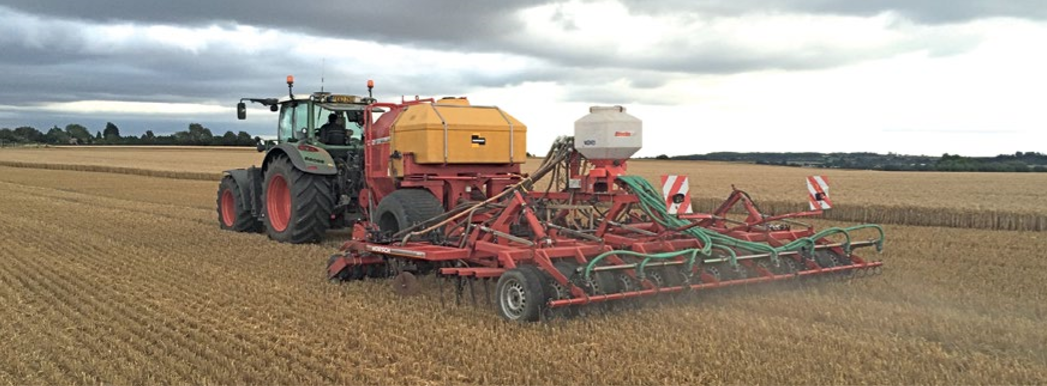
How To Start Drilling For £8K
Clive Bailye’s seed drill of choice is his 6m John Deere 750A , which has been used exclusively for 3-4 seasons. Last year, with an increased acreage, the founder and publisher of this Direct Driller magazine thought a second seed drill was necessary. Having just the one machine was a risk and in a difficult season would mean drilling was delayed. He looked around and found a good condition Horsch CO6 tine drill advertised in Germany.
Words and pictures by Mike Donovan
After delivery he rebuilt the coulters to a narrow profile so as to reduce soil disturbance. He says the tine drill is very useful driling after straw crops such as osr and also through the straw on second crop cereals.
Buying the drill from a German farmer was not particularly complicated, and provided him with a higher spec machine than Horsh sell in the UK. The seed dart tyres are much wider, and the machine is fitted with blockage monitors as well as full width front packers and also a liquid fert application system.
A sheaf of photos were taken, and Clive then asked for some of specific parts to show wear. The deal was done at under £5,000 which Clive says is the market value of these machines which are too large for small farmers to buy. Original owners like to buy new and sell when the machine is still in good condition.
Narrow tines with wear tiles
@Clive knew he wanted to make changes, substituting the Horsch tines and coulters for something far narrower, and has ended up getting his own design of tine made, which has a wear tile made from Ferobide, far harder than tungsten. The drill is on the farm primarily for osr and 2nd crop cereals drilled into chopped straw and the 25cm spacing is okay for these crops.
Comments on Clive’s on-line forum, TFF, said the drill many not be so good with beans, as the slot is a mere 12mm wide. And in barley the spacing may well be too wide as it needs to be thick. Clive points out that the seed pipe can actually be a bit wider than 12mm as it is in the shadow of the point. It would be good to have the option of using it for beans.

Above left: The cheap CO6 is being calibrated ready for its first outing

Above right: The adapted Horsch is being filled by the home built drill logistics trailer with seed and liquid starter fert.
Getting around the German instructions
The Horsch came, of course, with a control box and instructions in German. More on-line discussion revealed that English instructions were available on the Horsch website, and another explained that Horsch was sourcing some of these parts from Agton in Canada anyway. Zealman from New Zealand explained that the button marked with callipers should be held down for around 5 seconds. The menu is where you adjust the tramline sequence, valve layout and row numbers.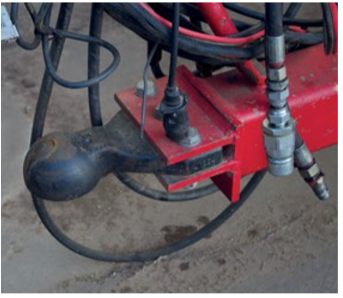
Ball hitch is a continental standard and provides a positive connection between tractor and drill

The Stocks Wizard has a rotor modified for Avadex which otherwise leaks everywhere
A Stocks Wizard is on the back of the drill and used for Avadex. Here again the knowledge of actual farmers is helpful. Alistair Nelson warned that the rotor and the surrounding shroud need to be changed, and he got good advice “from Rick at Stocks”. Clive has the same setup on the 750A and says that the Avadex leaks everywhere unless the modification is made. The drill was acquired and modified in 2016 and the results have been excellent.
The machine went through the residue without many problems and having the second drill has meant more timely planting. Clive has shown that moving into No-Till is not the expensive exercise so many farmers think it might be. The total cost, after modifications which included replacing all tines and coulters, was under £8,000.
Author Mike Donovan writes: we have featured a number of home made direct drills in @Practical Farm Ideas, and are always interested in seeing more. Please contact mike editor@farmideas.co.uk or 07778877514.
-
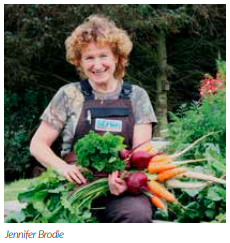
Evolving Benefits Of Using UK Volcanic Rock Dust
Written by Jennifer Brodie from REMIN Scotland Ltd

A 5-day FACTS Course at SRUC, Craibstone, Aberdeen confirmed our soil is a mix of 5 ingredients: air, water, decayed organic material, minerals and living organisms. After 15 years working with ancient Scottish basalt, that erupted onto Planet Earth 360 million years ago, before vertebrate life lived on land, I am convinced that it is the interaction of these last 2 ingredients, in the soil, ie minerals and living organisms, that is the key to good health. This is health not only of our soil, but also our plants and animals, ie our food, ourselves and our planet.
As illustrated by Dr Elaine Ingham’s excellent work on the Soil Food Web it is now evident that decades of intensive farming have drastically damaged the life in our soil. The hijacking of agriculture by chemistry over biology has resulted in the loss, or locking up, of our soils minerals and trace elements leaving the soil biology in no fit state to make them biologically available to plants. The McCance and Widdowson paper shows the mineral content of our food crashed drastically from 1940 to 1991. Further exasperated by food processing, this is leaving us overfed and under nourished.
So yes, whilst chemical analysis shows many soils are short of specific minerals and trace elements, I am here to tell you the full quota of 17 are present in REMIN volcanic rock dust – and worms love it! This award winning, organically approved, freshly crushed, finely screened dust is currently sourced from one Scottish Quarry. It shouldn’t be puzzling, but it often is, why the benefits of volcanic rock dust are far more evident when applied to gardens than when applied to farmland. A key farming client is Chris McDonald of Bays Leap Farm, near Newcastle. His application of REMIN was featured in a recent broadcast of Channel 4’s Food Unwrapped when Chris walked the talk with presenter (and pig farmer!) Jimmy Doherty.
The programme included an excellent piece by Sheffield University’s Professor Johnathan Leake where he compared a soil sample from a wood coppice, with the soil in an adjacent cropped field. The difference in soil biology was dramatic with the undisturbed soil in the wood hosting a healthy population of worms whilst the famers field appeared lacking in life. Aristotle told us 350 years ago, worms are the intestines of our soil. As Prof Leake showed in this example, the life in some farmers soil is visually gone. It therefore takes longer to show the dramatic benefits that the gardeners are finding in their less intensively worked and more biologically active soil.

The best farming result I have seen is Warwickshire sheep farmer, Ted Mawby who mixed 4 : 1, by volume, with cow manure resulting in the best pasture Ted has seen in his 24 years of farming. The minerals and microbes in Ted’s mix would appear to be working together to produce exceptional results. Having exhibited at the ace Groundswell in 2018 it was then fabulous to get a 28t bulk REMIN order from John Cherry to mix with his compost windrow. This pile was turned with their new compost turner supplied by BJC Smalley and Co from Berwick and this was demonstrated at Groundswell 2019. Livestock farmer Alex Brewster of Rotmell Farm, in Perthshire has used our products since August 2017. Alex selected one field as a control, applied just REMIN to a second field and REMIN plus cow manure to the third.
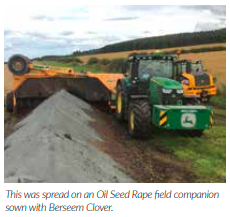
When I visited Rotmell, Alex showed me whilst REMIN / FYM application displayed the biggest difference, the benefits of the just REMIN was also evident in the health and the yield of the crop. In Alex’s words “We are clearly onto something and I am particularly keen to follow through on the minerals / microbes aspect of the product.” For 2019 Groundswell I invited Jersey based UK Soil Food Web consultant, Glyn Mitchell of Credible Food to share our stand. We then went straight on to run a minerals and microbes course at the lovely Cabourne Parva Farm in Lincolnshire, that has good conference holding facilities. Here farmer, Peter Kirke, as well as including bulk loads of REMIN in his windrowed farmyard manure, wood chip and silage grass, boosted his compost tea with our product and we look forward to seeing the results.
This August the afore mentioned BJC Smalley took 2 bulk loads. I visited them in September and saw their windrow composting where the REMIN had been added. The photo below was taken by Hughie’s son Michael Leyland, who is a dab hand with the drone camera, of their Windrow mix topped with 2 bulk loads. I have so much more to share including the very topical (and fantastically exciting!) inorganic carbon capture of carbon by freshly crushed rock dust and the organic carbon capture as the soil biology, plant productivity and health increases. We know anywhere in the world with volcanic soil, ie soil close to recent volcanic activity, is exceptionally fertile and productive. With a decade and a half of seeing for myself what REMIN can achieve in gardening soil, all around UK and abroad, all I can say is “Stop havering, and try it for yourself. Just like the gardeners before you, I fully expect you will be back for more!”
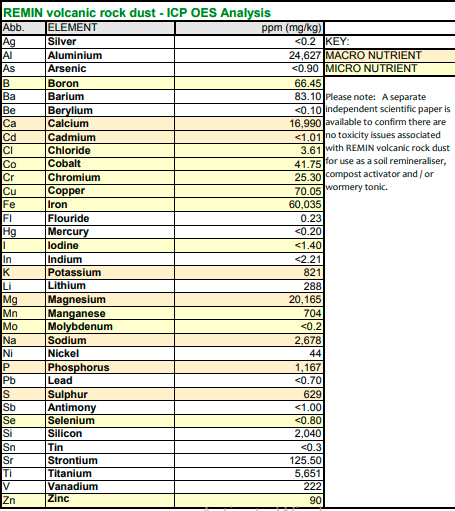
-

Drill Manufacturers In Focus…
MZURI SAYS DON’T COMPROMISE THIS SPRING

Headed by farmer and engineer Martin Lole, Mzuri is a leading manufacturer of strip tillage seed drills that have been tried and tested on the company’s trial farm since its inception. Formally a conventionally managed farm heavily infested with a high burden of blackgrass and charlock, the Mzuri Pro-Til system has turned the arable enterprise around to become a clean, productive and sustainable farm.
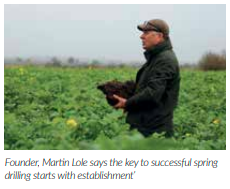
A large part of the trial farms turnaround has been put down to widening the cropping rotation and including more cover and spring crops, something that the manufacturer advocates and is easily achievable using the Pro-Til drill. With the exceptionally poor weather restricting much of drilling during Autumn 2019, the manufacturer suggests getting spring cropping right will be even more important this year. Designed to deliver quick and consistent establishment direct into residue the Mzuri Pro-Til drill boasts several innovative features that make it ideally suited to spring drilling and getting a crop up and away quickly.
Cover crop no problem
Advocating retaining as much surface residue as possible prior to drilling, Mzuri chop and spread their straw with the combine on their trial farm and establish high volume cover crops to provide biomass, retain soil moisture and increase organic matter. As a result, the trial farm has seen their soil organic matter double, thanks to retaining previous crop residue on the surface and allowing nature to take its course. The Pro-Til has been engineered to drill directly into residue such as this, by moving trash out of the seeding zone with the front leg whilst creating a friable strip to seed into. The residue free, loosened strip provides the perfect nursery seedbed for germinating seeds whilst untilled surrounding soil provide the perfect environment for roots to thrive, giving the crop the best start. Drilling into cover crops is made even simpler with the Pro-Til’s staggered layout. Reconsolidation wheels and tine coulters alternate, aiding the flow of residue through the machine, allowing for minimal moisture loss during the critical spring season.
Fertiliser where it’s needed
With a shorter growing season, getting a spring below the seed where it’s needed, with moisture preserved and readily available to activate it. Not dependent on rainfall to wash in any nutrients and being placed in a targeted zone makes for a competitive crop, limiting the nutrient supply to weeds.
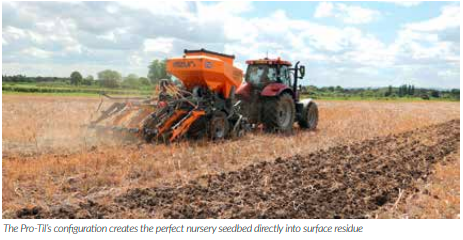
Band fertiliser placement holds a whole host of benefits to those in catchment sensitive areas where targeted application reduces the risk of run off and nutrients finding their way into watercourses. The manufacturer also suggests that accurate fertiliser placement can improve the efficiency of applications and gives roots the best chance of uptake where typically nutrient absorption, soil chemical reactions and nutrient movement to roots are generally much slower at lower temperatures.
Consolidate and reconsolidate
The Pro-Til is designed to consolidate multiple operations including seedbed preparation, fertiliser placement, reconsolidation, seeding, slug baiting and harrowing in one pass. With this in mind the manufacturer suggests significant time and fuel savings can be made to drive down costs and improve profitability. Featuring dual reconsolidation from the main centre and press wheels, air pockets are removed and create excellent seed-to-soil contact with many users opting for no additional rolling post drilling.

By consolidating these stages into a single pass, the Pro-Til gives operators greater flexibility to pick their timings and delay drilling to coincide with soil temperature whilst not compromising on quality of establishment.
Accurate seeding depth
Timing is critical, not just in the spring but throughout the crop’s life, from chemistry applications to even senescence. To achieve a consistent crop from headland to headland, Mzuri pride themselves on accurate seeding depth even over undulating ground. Their patented independent, hydraulically pressurised, pivoting coulters ensure accurate drilling depth is retained across the field, promoting consistent emergence in a narrow window.
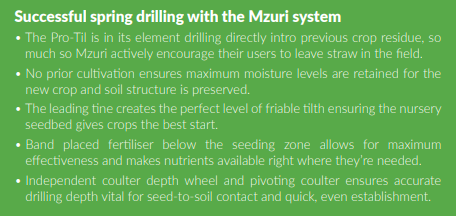
On their Worcestershire trial farm this even emergence has proven widely beneficial from a crop management and pest control perspective and has evened out inconsistencies associated with their previous conventional system.
Flexibility is ability
With a range of coulter options and leg configurations the Pro-Til system lends itself to a variety of spring cropping options including, beans, cereals, oilseed rape and maize. The popular Pro-Til Select model allows operators to drill on 33cm or 66cm row widths at the switch of a button. Coupled with single or dual band coulters, or the Xzact singulation seeding unit the Pro-Til is a versatile solution for a range of soil types – whatever the season.
-
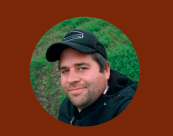
Farmer Focus – Steve Lear
Mother nature was going to give me a kicking at some point!

Since starting our no till journey, a couple of years ago, I haven’t really had too much to complain about. We have had two easy autumns where we were able to get a decent amount of ground drilled without too much of an issue. Its been two of the driest years that I can remember and that tends to favour no till. Our yields haven’t really been any different from when we were cultivating, in fact if anything we have seen a yield increase on some land and certainly in winter barley. So, I knew at some point mother nature was going to throw us a curve ball. But instead of a curve ball she pitched one up straight into the goonies.
The soils at the end of harvest were in a great condition and I was looking forward to a nice easy autumn of drilling as soon as we got a chit on some blackgrass. Unfortunately, the weather had other plans. When it eventually started to rain it didn’t really stop and this has caused havoc with our drilling plans. The ground has never really dried out enough to get on it in our area. A few farms have mauled crops into cultivated land but we soon learnt after trying to travel on wet soils that we were going to have to call it a day with only 150acres drilled out of 1500 planned. We didn’t want to undo all the great work that we had done in the past couple of years for the sake of a poor winter crop and a 12-ton drill on wet clay is not very clever.
On the plus side, some of our cover crops look great. We established an oat and mustard mix behind whole cropped wheat in July which is now nipple high and has some fantastic roots on it. We have a multi species cover crop over 150ha with mixed results depending on how early we got it established. The idea was to graze all our covers this year with some neighbour’s sheep, unfortunately the persistent wet weather has meant that we didn’t dare let livestock on the fields as small feet on saturated clay would have resulted in a compacted mess.
The weather has however meant that I’ve had the time to go around the farm and do a lot of soil sampling and testing.
The following tests were carried out on a field by field bases: An infiltration test, A worm count, slake test, a photo of the structure is taken and a soil sample is sent off to NRM labs to carry out their soil health suite. This includes tests for: Ph, P, K, mg, Organic matter, Co2 burst and textural classification. This year I have also been testing an area on the farm that has been in a natural cycle for as long as I can remember. It grows chest height grass every year and has zero management. I will use it to bench mark my soils across the rest of the farm to see where the soil has the potential to get too.

The infiltration test on the natural area showed that we have a way to go with our soils in terms of improving them. I couldn’t believe the amount of water I could pour into the pipe on the natural area before it started to back up. We will also be doing all we can to raise organic matter across the farm by using grazing stock, cover crop and manure applications. The other interesting observation from doing these tests was that the natural area had very few worms in compared to the arable land, the few worms that were present were enormous though.
We over seeded a large percentage of our grazing ground again this autumn by grazing the sward tight to the ground and then drilling grass seeds and herbals into it before the rain hit. We drilled the fields with cattle still grazing in them, the cattle were moved on after a couple of weeks to let the new seeds establish. This system works really well for us and means fields aren’t shut up for reseeding for long. It will be interesting in the spring to see how the herbal plants do against the grass. I’m hoping they will keep growing throughout the summer when the grass starts to slow up as they tend to have deeper tap roots.
It’s been a frustrating autumn but we aren’t in as bad a situation as some that I’ve seen in the farming press. It must be heart breaking seeing your farm and livelihood under water and my thought go out to the families affected by the flooding around the isle. Stay strong and keep your fingers crossed for a friendly spring.
-
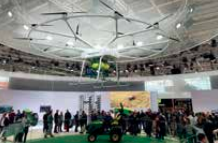
Future Farming Technology From John Deere
There have only been a few times in my life I have been truly wow’d at an agricultural show. But I certainly have one more to add to the list after visiting the John Deere stand at Agritechnica 2019. As always, the stand was big, and we were very lucky to have Nathan Kramer from the USA to show us around the new X9 combine. Although Nathan left out a lot of the still to be announced details we really wanted to know! But it was stepping into their future technology zone that really captured the imagination. Its was a mix of real world and possible solutions for farming. It was, however, all very people centric. Tools to help farmers do a better job, not tools to replace farmers. This was a nice thing to see.
Here is a little walk around the Future Technology Zone and a little bit about each of the displays.The biggest drone I have ever seen!
On show was a demonstrator model of the VoloDrone equipped with a John Deere crop protection sprayer, which is ready for its first field flight. Offering a potential payload of 200kg, the VoloDrone is able to cover a big area, even when ground travel conditions are far from optimal. The drone is the result of a collaboration between John Deere, who bring the requirements of farmers and the Urban Air Mobility pioneer Volocopter, who are working on producing flying taxis for moving people from A to B. While small drones are already being used commercial in China, large drones in agriculture where you are trying to spray bigger areas could be the way to go. The VoloDrone is not limited by topography, spraying hillsides would be much easier! But it could even be used for sowing seeds.

The VoloDrone is powered by 18 rotors with an overall diameter of 9.2m and features a fully electric drive using exchangeable lithium-ion batteries. One battery charge allows a flight time of up to 30 minutes. The VoloDrone can be operated remotely or automatically on a pre-programmed route. The main issue of course being that in the UK that the aw does not allow us to use drones to drop anything from the sky, but by the time our learned government get round to changing UK legislation I would imagine this technology will be ready.
See and Spray – Blue River
Continuing on with the spraying theme, but applied in a more conventional matter, John Deere introduced Blue River’s “See and Spray” technology. The aim of this software is to save 90% on herbicide usage by only spraying weeds that are identified while opening the potential to use other herbicides that are not appropriate for blanket application.
How it works:
Sense & Decide – their machines see every plant and determine the appropriate treatment for each. They have developed intelligent models using computer vision and machine learning that can distinguish subtle differences between plants and weeds of many species and sizes. See & Spray does not rely on spacing or color to identify weeds. Instead it has the ability to recognize differences between plants in conditions that would challenge even the human eye. Robotic nozzles target unwanted weeds in real time as the machine passes. With great accuracy and precision, See & Spray applies herbicide only to weeds, avoiding chemical application on the crop or on areas without weeds. Precise application allows growers to reduce chemical usage significantly and unlocks the ability to use herbicide alternatives to effectively control weeds that would otherwise be resistant.
This is the sort of spraying pattern you get:

Watching the demo on the John Deere stand and talking to the Blue River staff made you realise how close this technology is to being available. And right next to the demo was an autonomous sprayer!
Autonomous Crop Sprayer
John Deere’s autonomous crop sprayer has a 560-litre spray tank. The high ground clearance of 1.9m and fourwheel steering make it extremely versatile, while the front and rear tracks minimise ground pressure and greatly extend the operating window. Just imagine this sprayer fitted with Blue River See and Spray technology.

Smaller “Hive” Technology Drones
While the Volodrone might be the right for certain farms, the ability to spot spray using smaller drones in fields will appeal to other farms. These smaller drones are equipped with weed identifier software and crop sprayer nozzles, allowing weeds to be identified from the air and then specifically targeted. The 10.6-litre tank is filled fully automatically at a vertical docking station, where the battery is automatically charged as well. Flight time with a fully charged battery is 30 minutes. The big advantage of this drone is the precise application of crop protection products, reducing the volumes used. This “stack” of smaller drones can be towed to the field and then controlled by a single operator (laws permitting) while that driver is doing something else in the field or adjacent field.
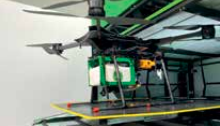
Electric Autonomous Tractor
John Deere’s new autonomous tractor concept is an electric drive unit that can attach to implements a farm already owns. The tractor has an output of 670hp, so will be able to pull most implements on a farm and can be equipped with either tracks or wheels. Where more weight is required, it can be ballasted up to 15t. In lighter trim without ballast, it has the ability to help reduce soil compaction. Thanks to the electric drive, there are no operating emissions and noise levels are extremely low.
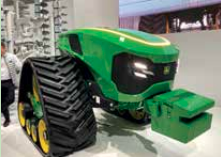
Further advantages include low wear and maintenance costs that accompany all electric vehicles. No information was available at the show on running times and recharge times, but as with all concepts, more details will emerge over the next few years. If you have multiple tractors on farm, I can see the possibility to change one of them to this sort of electric tractor would be appealing in the future. As always, it’s this transition period in the adoption of technology that presents the biggest issues on farms.
John Deere’s Futuristic Command Cab Control Centre
We were introduced to Neil Macer, John Deere’s product manager for this project, who gave us a tour of the technology being employed within the Command Cab. This isn’t a operational system, but more a vision from John Deere of how a future cab employing artificial intelligence (AI) could be operated by farmers. With its central touchscreen display giving full farm visibility, networking of all machine components, John Deere presented a vision of how a connected farm could operate. It integrating real-time weather data, all machines on the farm or within your contracting business, individual machine monitoring and job management, the cab becomes the command centre for all agricultural operations. Equally this information could also be available in the farm office. Vertical digital satellite and fuels displays were also on the A pillars and a secondary curved screen also spanned around the top of the cab. Plenty of screen space to have The Farming Forum live on the screen at all times!
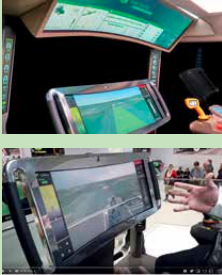
Summary
We spent over two hours talking to the John Deere staff in the Future technology zone. The fact they were showing these new ideas at Agritechnica means we are unlikely to see any of this technology on farm within the next 5 years, but you couldn’t help being enthused by the possibilities available in agriculture. If children in school saw this, I think the idea of a career in farming would be a lot more appealing. It really is an exciting time to be a farmer.

-

Base-UK

BASE-UK was established in 2012 and is independent of all businesses or organisations. We provide a forum for members to share information, experience and ideas on conservation agriculture, which includes topics such as minimum tillage, direct drilling, cover cropping, integration of livestock and many other techniques offering more sustainable agriculture by working in harmony with soils and the wider environment as well as inviting industry experts to speak to members.
BASE-UK shared a stand at CropTec with Direct Driller Magazine and the Farming Forum and jointly hosted “Soil Hubs” where some of our members stood on a panel for Q&A discussions on Integrating Livestock into the Arable System; Cover Crop Strategies and Widening the Crop Rotation. These were well received and provided a great opportunity to encourage the audience to take part and ask questions with farmer to farmer knowledge transfer being key as per the principles behind BASE. Thanks to Steve Lear, John Cherry, Angus Gowthorpe, David White, James Warne, Tom Storr, Andrew Jackson, Clive Bailye and Adam Driver for their contributions.
As this is written, a group of 20+ members are visiting Frederic Thomas along with Frederic Remy and other farmers in France for a knowledge exchange trip and to compare notes on how to cope with the wet conditions experienced this autumn (and of course to sample the local culinary delights).
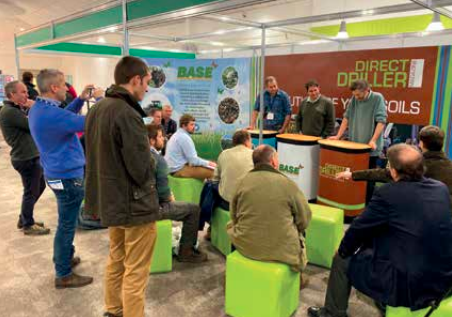
Details about our upcoming AGM Conference in February 2020 are on our website www.base-uk.co.uk We have a variety of different speakers including Dr Sam Cook, Dr Anna Krzywoszynska, Professor Adrian Newton, Dr Lea Herold and some of our own BASE-UK members including SFOY Julian Gold.
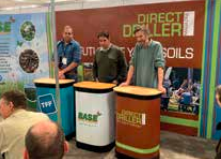
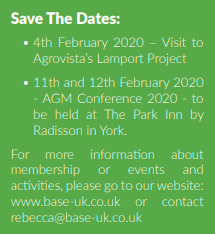
-

Drill Manufacturers In Focus…
WET YEARS ARE NO GOOD FOR DIRECT DRILLS

Oh dear! RAIN, RAIN, RAIN.
“A wet seasons no good for direct drills LAD” is the chant we hear incessantly, often with no experience of any Direct Drill. Yes it is, unworked stubble stands more water than worked, cover crops stand much more water than anything else and provided the tractor is suitably tyred and you’re not damaging the structure, if it’s not balling up on the wheels then we CAN direct drill. Image 1: Drilling Winter Barley in wet wold land as the storm clouds gathered, if only we knew! This crop is establishing as well as conventionally drilled barley in the next door neighbours field, but for a much lower cost, financially and structurally, they had 6 metres and 300hp, here we have 5 metres and 150hp. Versatility and adaptability has to be the name of the game in a wet season, the Ma/Ag can work in any direct drilling situation and can drill on any kind of cultivation, even straight onto ploughing.
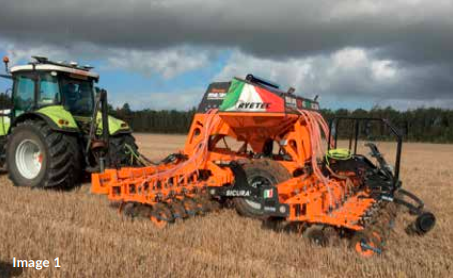
Image 2: The Ma/Ag wide rubber press wheel, means the drill is riding on rubber equivelents to more than ¾ of the drilling width, it travels even on fluffy soils like this one and leaves a firm finish with seed in the right place., the fields rather than the bag !
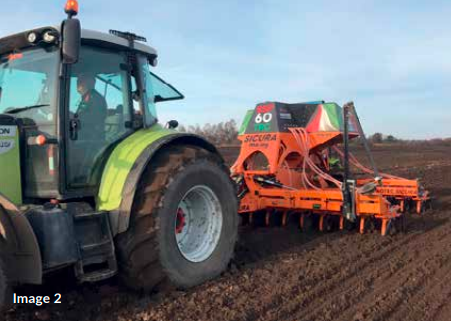
Image 2: Here we prove that a grass ley can easily be direct drilled, grazed as late as possible, no disturbance and maintaing soils structure, its just coming out now, quicker than some ploughed and power harrowed land opposite !
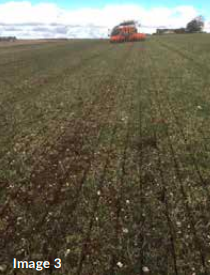
Updates on the crops next time.
For more information, contact
Ryetec, 01944 728186 -

Carbon Footprinting
Written by Becky Willson from the Farm Carbon Cutting Toolkit
The old adage of you can’t manage what you can’t measure is certainly true of carbon accounting.
But when it comes to agriculture, measuring carbon isn’t as simple as it may first seem. The variation of emissions and carbon stocks are due to the fact that we are trying to measure biological systems, which are impacted by climate, soil type, topography and vegetation, as well as what we as farmers are doing in terms of our management. Which makes the whole thing a little tricky. However undaunted by this complexity, carbon metrics are an essential tool that farmers can use to not just identify climate solutions, but also to baseline the farm’s emissions and drive technological change. Identifying the carbon footprint of a farm business is the first vital step in being able to quantify the contribution that the farm is making to climate change. A carbon footprint calculation identifies the quantity and source of carbon dioxide, methane and nitrous oxide emitted from the farm (as well as carbon sequestered in soils and woodland) highlighting areas where improvements or changes can be made to reduce greenhouse gas emissions.
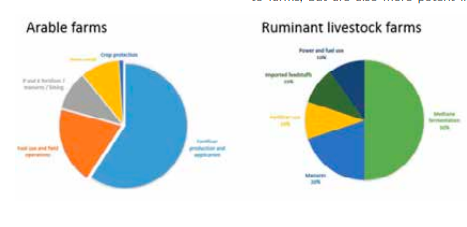
Unless you have been hiding under a rock recently, you can’t have failed to notice the increased attention that the carbon credentials of farms has been receiving. Whether it is a way to assess the sustainability of one diet choice over another, or a report on the often outlandish claims of livestock production systems, carbon is everywhere. But what does it really mean for the farmer, and is there truth behind the rhetoric? Greenhouse gases are much talked about but they are inherently intangible. You can’t see, taste, hear or touch them; and they are all gases that are released in relatively small quantities on a continuous basis. So how do we understand what is going on with them and how do we talk a common language?
Outside of agriculture and when looking at reports, emissions are commonly communicated about as carbon emissions.
However on the farm, carbon dioxide isn’t the main issue, it is mainly the emissions occurring as nitrous oxide and methane which are not just a larger part of the emissions attributed to farms, but are also more potent in terms of their effect on the warming climate. In order to make sure that we are all talking the same language, all emissions are converted into a carbon dioxide equivalent (with methane being 30 times more potent and nitrous oxide 298 times more potent than carbon dioxide). By converting them all to carbon dioxide equivalents (CO2e) we can talk in a common language about kilos or tonnes of CO2e.
Reducing carbon emissions in a farming business makes sense on many levels. High carbon emissions tend to be linked to high use of resources, and / or wastage, so reducing emissions also tends to reduce costs. This makes the farm more efficient and should improve profitability. As well as the business opportunities that come from reducing emissions, farmers and land owners are in the unique position to be able to sequester carbon both in trees, hedgerows and margins and within the soil. Before being able to reduce emissions, you need to know where the emissions are coming from. Are the largest emissions coming from livestock, soils, fuels, or fertilisers? It is vital to get a picture of your business which is made possible by carbon footprinting.
Choosing a tool to use
There are various carbon footprinting tools that have been designed for use by individual farmers (or groups of farmers) who are interested in understanding what is happening on-farm. Although the simple principle of completing a carbon footprint assessment is the same (emissions minus sequestration equals footprint), within that there remains variation between what scope and boundaries the tools use to calculate the results. Boundaries of a calculation determine what aspect of production is being assessed; for example whether you are calculating the emissions associated with one farm enterprise or the whole farm, or whether it is assessing operations within the farm gate or taking account of what happens off farm. A key part of deciding what tool to use centres around what you want to use the footprint for.
Marketing – if you are wanting to use the results for marketing purposes, it is a good idea to choose one that has a clear method attached to it, which sets out what is included and excluded from the calculations, that way you can be completely transparent about your carbon credentials. A management tool – if you are planning on using the results and the data as a management tool, perhaps to highlight areas to improve in the future, then you will want to use a tool which allows you to evaluate the impact of changing your management. These tools tend to need more data added in at the start so that the impact can truly be seen. An interest – if you are just interested in what might be happening in carbon terms on your farm, then again choosing one that explains clearly what is included and omitted, and shows the footprint broken down into key areas is a good starting place.
Sequestration – in or out?
A key question to look at when footprinting is whether carbon sequestration is included in the calculation. Carbon captured within trees, hedgerows and field margins as well as the carbon held in soil is an important part of the footprint and shouldn’t be overlooked. If the tool doesn’t include sequestration then the footprint will be looking at the negative without the positive! There are a range of options that start from free tools that can be used in the farm office to paid for services that come with an advice service attached to them with recommendations for the future.
There are some supply chains within agriculture where carbon footprinting is already taking place. Most dairy farms are already being foot printed as part of their milk contract, however in other farming sectors the take up has been slower. Tools include the Cool Farm Tool, AgreCalc (which is used in Scotland) and the Farm Carbon Calculator. The golden rule is, once you have decided what tool to use, stick with it, as there are differences within the methods used in each calculator, so comparing results between calculators is meaningless.
Getting started
Once you have decided which tool you are going to use, the first step is to gather all of the input data. This includes information on fuel use, livestock numbers, fertiliser inputs, use of materials, waste produced etc. In order to be accurate you need to be comprehensive in your assessment. The list can look daunting at first, but if your record keeping is reasonable then this process should be achievable in a couple of hours. One you’ve done it, the next time will be quicker! Once you have the data, it’s just a case of entering it into the calculator, which shouldn’t take more than an hour, after which you should have a breakdown of carbon emissions by sector, both in amounts (kg or tonnes of CO2) and percentages of the total footprint by category. Armed with this data you are then ready to think about how to reduce emissions and increase sequestration.
When completing a carbon footprinting although value can be seen from completing it as a one off exercise, the really interesting part comes when the process is repeated at regular intervals, usually annually. When you do this you can start to see what direction the farm is moving in and whether the actions you’re taking are working.
Emissions sources
Although each farm will vary in its carbon footprint, the charts below show the average breakdown of emissions across a typical livestock and arable farm.
Next steps
So once you have the footprint of the farm, deciding what to do is the next key step. The footprint result will be reflected as a carbon dioxide equivalent, but should also show you where the emissions of nitrous oxide and methane are produced. Key areas to focus on are the management of soils, fertilisers, manures, livestock, cropping, energy and fuel. There are numerous opportunities to reduce emissions and costs as well, leading to improved resilience and profitability, as well as opportunities to improve carbon sequestration and soil health, the ultimate resilient business model! Absorbing more carbon than the farm emits is a goal that all farmers could work towards and understanding the farm’s current carbon position by footprinting is the first key step.
Currently agriculture is one of the only industries within the UK which is under voluntary greenhouse gas emissions reductions, however we are not going to be in this position for long. The spotlight is being well and truly shone at agriculture’s carbon credentials at the moment, and this offers an opportunity for us to take the first step and understand what is happening on our individual farm, and what we can do to improve profits, reduce emissions and build soil health and sequestration. Carbon offers a fresh lens through which to evaluate our business and build resilience for the future.
Footnote – Farm Carbon Cutting Toolkit – which provides practical help and advice to farmers on reducing greenhouse gas emissions, improving energy resilience and building soil health. FCCT’s carbon calculator has been designed by farmers, is free to use and the new version will be launched at the Oxford Real Farming Conference in January 2020.
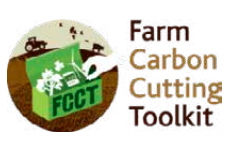
-

Investigating The Combined Effects Of Tillage, Compaction And Cover Crops On Soil Health, Yield And Controlling Grassweeds In Spring Cereals
Written by David Purdy from John Deere, based on work at Agrovista’s Project Lamport
A project, now in its 7th year, initially developed and managed by industrial partner AGROVISTA to study the cultural control of blackgrass at their flagship Lamport trials site in Northamptonshire used cover crops in conjunction with spring cropping to develop a rotational production system to manage blackgrass populations on heavy soil types. Early observations and successes suggested as well as controlling blackgrass, reducing headcounts from over 500m2 to less than 2m2 for example, the soil also improved as well as maintaining sustainable spring wheat yields. To study these effects further a larger fully replicated trial site has been developed at the same location. The background to the trial focuses and expands on the findings at Lamport along with some of the wider significant challenges and limiting factors on cereal yields and profitability in the UK. These include declining soil organic matter and soil health, soil compaction and obviously grass weed control. After soil organic matter reduction, soil compaction is one of the most damaging factors for plant growth and yield.

As machinery axle weights increase further deeper compaction is inflicted on soils resulting in further subsequent damage. However modern tyre technologies and lighter axle weights can help mitigate the damage. Tillage is used to break up the compaction and restructure soils to enable crop growth and development but often has further damaging effects for example the further loss of soil organic matter with the associated negative effects. Finally, the blackgrass issue has grown out of post emergence herbicide resistance and therefore increasing populations which has made control in winter cropping of cereals more challenging, therefore, spring cereal production systems are often used as a cultural control mechanism to help deal with blackgrass.
The use of cover crops is growing in the UK, however their scientific understanding on the effects on soil health factors, spring cereal crop yields and their part in blackgrass control is limited. This trial using large replicated field trials running from 2018 – 2021 will investigate the effects of low disturbance tillage, different levels of compaction, lower axle weights, modern tyre technologies and cover crops in a spring cereals production system. The overall aim is to understand the combinations of physical treatments with the biological impacts of plant rooting systems of cover crops to improve soil health, ensure resilient yields and control blackgrass in a spring cereal production system, in summary the roots verses iron philosophy, allowing at capture of carbon through photosynthesis to feed the soil food web which in turn delivers gains to soil health.
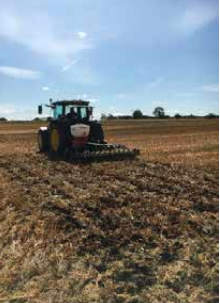
Two large replicated trials have been established. The first, fully replicated 32 plot experiment, established in 2018 compares the effects of low disturbance tillage at 20cm and zero tillage with the biological effects of cover crop species black oats and phacelia grown both individually and combined.
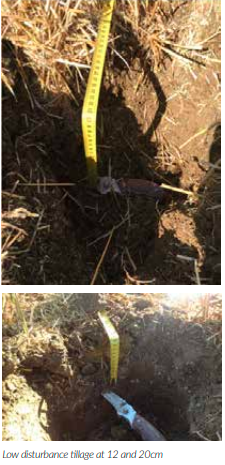
The second fully replicated 48 plot experiment established in 2019 compares the effects of pre compacting the soil at two different tyre pressures on lower tractor axle weights, low disturbance tillage at two different depths with the biological effects of black oats and phacelia cover crops combined. Along with control plots and replication these trials result in a large 96 (12 metre x 12 metre) plot trial site.

Their effects will be assessed with range of physical and biological measurements including water infiltration rates, soil structure, bulk density, penetrometer resistance, shear forces, organic matter, worm numbers, decomposition rates, mycorrhizal colonisation and yields among others. Were appropriate precision farming technologies such NDVI and telematics are being employed to measure cover crop biomass and fuel consumption.
The objective is to build a production system that improves soil health and in turn resulting spring cereal yields and well as managing blackgrass to low levels. Early results are showing some positive results including,
• Worms are increasing under cover crops but declining under tillage.
• Soil structure and aggregation are improving under cover crops.
• Spring wheat yields are improving after good cover crop biomass production
• Blackgrass control improves after cover crops
• Combinations of cover crop and low disturbance tillage has yield benefits to subsequent spring cereal yields
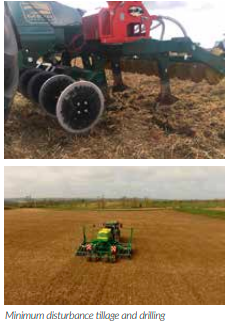
Along with specialists from Agrovista the project partners include Philip Wright from Wright solutions and well as various specialist machinery providers. The research forms part of a PhD programme at the University of Nottingham. Project Lamport has open days in July where further details and result will be presented
-

Using Wildflower Strips For Pest Control
It is easy to paint a bleak picture about the future of agriculture both in the UK and globally. Whether its pesticide use
and insect declines, run off and water quality, or greenhouse gas emissions and climate change, it seems like every
week there’s another negative news story about farmers and the UK countryside. But whilst widely rounded upon as
the villain, farming is uniquely placed amongst business sectors as it also holds the key to helping solve many of our
environmental challenges.It is easy to paint a bleak picture about the future of agriculture both in the UK and globally. Whether its pesticide use and insect declines, run off and water quality, or greenhouse gas emissions and climate change, it seems like every week there’s another negative news story about farmers and the UK countryside. But whilst widely rounded upon as the villain, farming is uniquely placed amongst business sectors as it also holds the key to helping solve many of our environmental challenges. Whilst I may be hopeful, growers are still facing a fearsome trio of issues – issues that pose a serious risk not just to their profits but to the nation’s food supply. First, over-reliance upon plant protection products has led to many pests becoming resistant to insecticides. And resistant insects in our fields means spraying simply becomes an expensive activity that serves no benefit, and in fact, will just cause unnecessary environmental harm.

Some might suggest that to fill this void that we can just develop new products, but this leads to our second problem. That there are few new actives progressing along the product development pipeline, particularly in minor horticultural crops, which often have to rely upon Extensions of Authorisation for Minor Use to tackle pests. And the third issue is the increasing legal restrictions upon products used to control insect pests – and the direction of travel is such that all products currently on the market will, at some point, likely also become subject to such restrictions. Time is therefore running out on the way that we currently farm, and It makes sense for us to find alternative methods of farming that don’t require us to rely on pesticide applications every year to remain profitable.
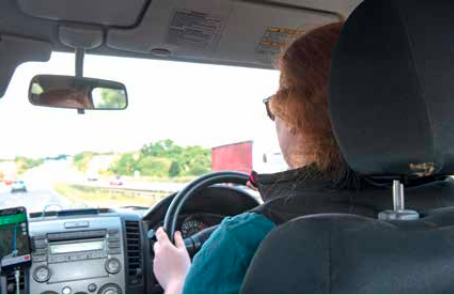
Conservation biological control has been suggested as a tool we can deploy which can relieve some of the pressure on plant protection products. This branch of biological control works by manipulating the habitat around crops to help support a group of beneficial insects often referred to as natural enemies, which includes the likes of ladybirds, hoverflies or ground beetles that naturally prey on pests. Typically, these resources are provided by plant mixes that we put into fields, traditionally either flowering field margins or beetle banks. By providing these potential allies with shelter, nectar, alternative food and pollen, the idea is they then move into the crop to eat pests and reduce crop losses. In high-value horticultural crops, there is even more pressure than in combinable crops to combat pest outbreaks and one crop I’m interested in particularly is carrots. In the UK, we normally grow 97% of the carrots we eat (unless it’s a summer like 2018 and carrots might yield up to 30% less).
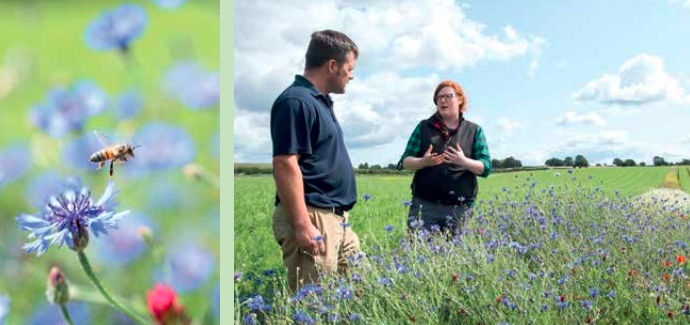
This means that any improvements to the sustainability of the crop mean real improvements to the UK countryside. For me though, this isn’t just a source of national pride, but actually is about taking responsibility for our food production and not just offsetting any environmental harm elsewhere. A big problem in carrot fields are the viruses which aphids transmit. These viruses can cause seedling death or impact carrot quality as the roots become split or visually diseased and can’t be sold. 2015 was a bad year for virus outbreaks, with carrot growers losing up to 15% of their crop. This cost the UK carrot industry £20 million, which is around 6% of the industry’s total annual sales.

As a result of this, in 2017 a PhD project was set up with an industry focused goal from the outset: what are the best plants we can sow to support natural enemies in carrot fields? With a willing partner in carrot farmer Ben Madarasi (who had already been conducting his own trials in Huntapac fields), we narrowed the problem down further: as carrot crops sown in early April are particularly susceptible to viruses. As Huntapac typically farm rented fields only available from Spring, it hasn’t been possible to establish perennial flowering strips. Therefore, we have been sowing plant mixes in the spring as the same time as the carrot drilling; using species that we know will rapidly establish to provide vital resources to the natural enemies.
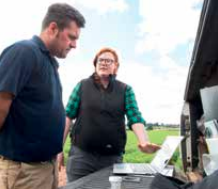
This limitation is a good example of the sort of issue that might not arise in a typical academic study, and by working with commercial farmers, we can also investigate which plant species ultimately have a positive effect on crop quality and ultimately profits. This is an important component of the work as if we are taking land out of production, ideally, we want only to offset the loss of land with increased carrot quality.
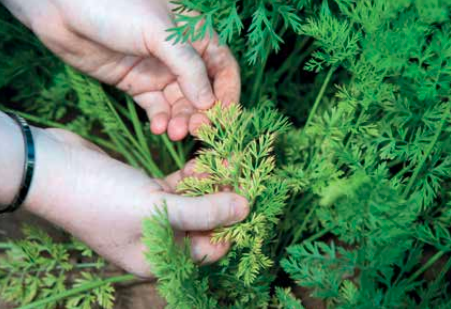
We are also studying where the best place to put these flowers within fields. We know that these flowers have a ‘spill over effect’. Where the natural enemies attracted by the mixes will move out from the flowers into the crop. But this effect decreases the further we get away from the flowering strips. So, we’ve trialled putting these into strips straight into the middle of fields, to deliver the natural enemies closer to where the pests are. We’ve found this year, working around machinery widths and Huntapac’s operational needs, that we can do this successfully! We are working to show that increasing natural enemy numbers in fields should help to reduce pesticide sprays.
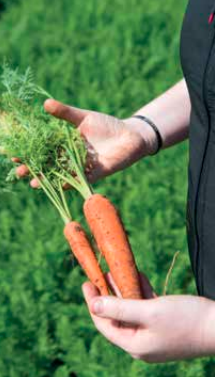
There is a growing body of literature that raises concerns about the impact of some agricultural practices, such as insecticide use and changing land use, upon wildlife like our insect populations. Even though carrots are harvested as roots that don’t benefit from pollination, these concerns have led to businesses like Huntapac wanting to farm in ways that are sympathetic to pollinators. As such, we have also been trying to support wild pollinators like bumblebees and solitary bees as these are not managed like honeybees. Without that careful management, there is a concern that wild pollinators are struggling to find enough nectar in early spring and later summer. Therefore, we are also trying to pick species for the strips that are still flowering in August and September. Readers of Direct Driller will also be aware that as the plant mixes sown include species like clovers, mustard and phacelia, there may also be improvement for soil health under the strips. Which all goes to demonstrate a key feature of these flowering strips – they are multi-functional, which will hopefully help to increase their uptake on farms.
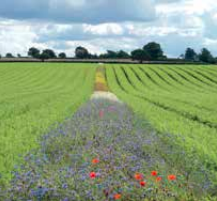
We’ve been collecting data on how well the plant mixes have established and know which ones establish quickly. The insect communities at the mixes are well studied too, we know which pollinators that have been visiting which flowers throughout the summer. We also carefully monitor the pest population to make sure we aren’t unintentionally increasing their populations too. We have now developed a technique for assessing the carrot quality next to the flowering treatments and we are finding differences between the plant mixes we are using. After two years of successful trials on Rothamsted Farm in 2018 and 2019 and a 12-hectare field trial in one of Huntapac’s commercial carrot fields in Shropshire, we are building up a body of encouraging results! Over the coming year, once we’ve had a chance to properly analyse the results, we hope to shaper our findings with the farming community – so stay tuned!
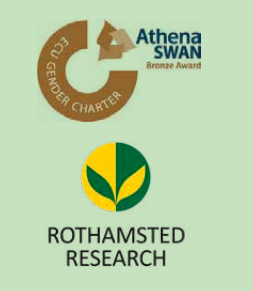
-
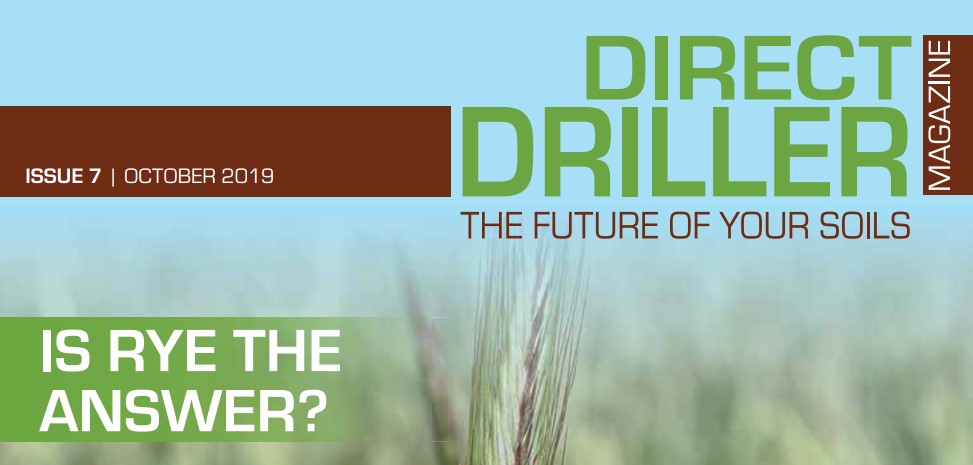
Introduction – Issue 7
A very warm welcome to this new issue of Direct Driller. There’s much to get your teeth into, including topics that are new but highly relevant. A glimpse into the future shows new crops on the cusp of becoming commercial. Why, for example, have we yet to realise the potential of rye? And in the longer term, what are the chances of growing perennial wheat in the next 20 years?
I like magazines which surprise me, and this one certainly does, with topics far removed from data technology, satellites, drones, robots etc. Here we have features which look at progress and technology which have yet to hit either the farming or national press headlines. This issue has its feet very much on the ground.
Contributors have real experience and expertise in both the practice and science of using and managing soil. Those planning to start No-till will find James Warne provides dozens of tips on pg 56. On pg 84 Andy Howard has some startling figures about real farm profitability. Those farmers whose cropping is restricted to the three cereals and osr may well find ‘buckwheat’, ‘phacelia’, burseem clover’ and so on somewhat daunting. Yet they make a valuable contribution to farming systems, so it’s worth getting acquainted with these strangers!
This issue of Direct Driller shows that the pace of change in the industry is not confined to electronics and mechanics. Once again we must thank those very many people in companies, institutes, universities who choose to support us, and of-course the numerous farmers who share their thoughts and farming methods. They all help to make this publication essential reading.
If you have something important to say do please get in touch with Clive or Chris – info@directdriller.com or me – mike@farmideas.co.uk



-
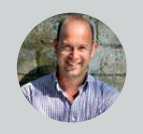
Featured Farmer – Jake Freestone
Farm Manager at Overbury Farms

The Farm
Overbury Farms is an integrated part of Overbury Enterprises which has been in the same family for over 250 years. It is a mixed farm that produces a range of crops including wheat, barley, oilseed rape (OSR), pease, linseed and soya beans. We also let out certain areas of our farm to specialist growers who produce crops such as onions and peas. The farm also has a flock of 1,200 sheep and home-bred Texel Cross Mules. The ewes are a mixture of Mules, Aberfields and Lleyn crossed Romneys. All lamb is LEAF marque certified which is an environmental assurance system that recognises sustainably farmed produce. Produce and livestock are sold to high street supermarkets as well as local markets and food outlets. OSR is sold on to Unilever and our barley is harvested and sold to Molson Coors.
Watch a video by scanning the QR Code opposite (recorded at an intercropping event) of Jake introducing the farm and talking about the importance of no till and cover cropping.

Sustainability In Practice:
Building soil fertility and reducing weeds through carefully planned rotations, no till, intercropping and cover crops The 6 year rotation at Overbury includes winter and spring barley, OSR, winter wheat, peas, linseed and soya beans. We have reintegrated livestock and now graze ley mixtures with home bred Texel, Abermax and SufTex lambs. This has the benefit of breaking weed lifecycles and also allowing the restorative periods in the rotation.
The system has been no till since 2013 (on some trial blocks, most of the farm came in from July 2015), which has had a very noticeable impact on soil quality, infiltration and biology – evidenced by some giant worms that we have found here lately! On most occasions we leave some straw and use mollasses and humates to help break it down. I don’t use seed treatments as the effect on mychorrhizzae is compromising the essential life in the soil, and instead have farm-saved untreated seed (seed is tested for fusarium mainly and if clean enough it’s not dressed).
If the soil is going to be uncovered for more than 5 weeks, I will put in a cover crop. In monoculture there is no room for genetic variation. A field of wheat is full of genetically identical plants and everything is vulnerable to the same pests and diseases. In a crop mixture you can guarantee that something will grow regardless of what conditions come your way. But it is not so much what happens above ground as below. Speaking to fellow Nuffield Scholar Andy Howard, I was inspired to give companion cropping a try…
Our most common species mixture (or ‘plant team’) is OSR, vetch and buckwheat. We have 4 hoppers on the Cross Slot drill (one also for slug pellets) and drill it at the same depth in the autumn – seed rates of approx. 7kg buckwheat, 2.5kg OSR and 13.5kg vetch per hectare (ha). As we found we were attracting a lot of pheasants in the crop, we are now using a mixture of 2.5kg/ha OSR, 2kg/ha burseem clover and 10kg/ ha vetch. Each species has different functions in the mixture. The vetch is deep rooting and breaks compaction to open up the soil for the OSR and also provides residual nitrogen; the buckwheat is good for creating a cover to smother weeds, making phosphate more available and distracting pests as well as providing a structural function to stop the crop going flat.
In these mixtures we use no pre-emergence herbicide as we rely on the competition effect to smother broadleaf weeds. Astrocurb is the only broadleaf herbicide we use to kill off the buckwheat and vetch and stop them growing over. Frost will take out buckwheat at less than 5˚C. A simple cost benefit analysis shows that despite the higher costs of seed, we are saving approximately £35/ha on inputs with the intercrop versus a monocrop of OSR.
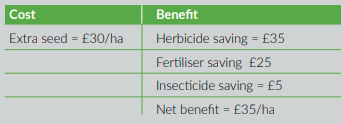
We also undersow a mixture of red clover, perennial ryegrass (PRG), plantain and chicory into spring barley. This year we had a yield of 6 tonnes / ha with no herbicide. I deliberately chose those fields that have a brome problem to help get on top of it. This then goes into a 2 year ley for sheep. Another mixture we are trying is kale undersown with white clover for fattening lambs. Once grazed we then direct drill winter wheat into the white clover. I am interested to continue experimenting with this – an understory of white clover for the whole rotation would be good. One example of this experimentation was a recent cover crop of rye, vetch, phacelia, and buckwheat drilled into soya ahead of soya beans which were planted the following spring. The cover crop provided a valuable habitat for pollinators in November when there is not much else available.
I am pleased to say that blackgrass is now a diminishing issue – it’s now just a spot of leisurely hand rouging on a Sunday afternoon! I think this is a combination of 5 years no till, spring cropping and having a cover at all times (if the soil is going to be bare for more than 5 weeks I put a cover in). We also try to drill later but I am cautious not to push it back too far in a no till system – although the soils are drier. There are barriers to farming in this way – there are some machinery requirements; we need to consider the rotation effects and limit the ‘green bridges.’ Finding markets for crops such as buckwheat is also a challenge, as is important to get spring crops to contribute enough to gross margins… But I think the biggest barriers are in our minds! Have to stop worrying what the neighbours will think and take the plunge and try something new…
Motivations:
Overbury Farms became a member of LEAF in 2003 due our core belief that intensive farming also needs to be environmentally sustainable. We then gained LEAF Marque status in 2007 and we proudly became a LEAF Demonstration Farm in 2012. This allows us to promote Integrated Farm Management (IFM) and show our strategies to achieve sustainable farming with the agricultural supply chain as well as the local community through farm visits. LEAF membership has helped us implement many strategies in order to enhance yields while being conscious of the environment.
In 2013 I was awarded a Nuffield Farming Scholarship to study the possibilities of growing 20 t/ha of wheat in a sustainable farming system while following IFM – ‘Breaking the Wheat Yield Plateau in the UK.’ Through this project I visited several countries including Canada, Mexico and the United States to understand the limiting factors of high yielding wheat crops and what the main mitigation strategies were that were in place. Differing climates produces a range of challenges when faced with growing high yielding wheat crops and this project allowed me to witness these problems first hand and to bring solutions back to the UK with the potential to use them on British wheat crops. One of the big eye openers for me was to realise that we are in fact abusing the soil by overcultivation. I came to the conclusion that we need more diversity to enable us to overcome some of these challenges. Increased soil management, more diverse rotations and livestock integration are all key to increasing wheat yields.
Farmer Tips
• Always keep soil covered.
• Consider what your objectives are with mixtures before selecting them i.e. weed suppression, increasing protein, combating pests and diseases…?
• The biggest barrier is in your mind!
Farm Facts
FARM SIZE: 1,538 hectares
MANPOWER: 6 full time staff
FARM TYPE: Mixed
NUMBER OF LIVESTOCK: 1,200 sheep
TENURE: Owner occupied
REGION: South West England
RAINFALL: 843 mm
ALTITUDE: 229 m – Bredon Hill Summit
SOIL: Brash
APPROACH: Integrated Farming
KEY FARMING PRACTICES: No Till Trap crops Mixed farming Companion crops Cover crops Diversified rotation Intercropping
-
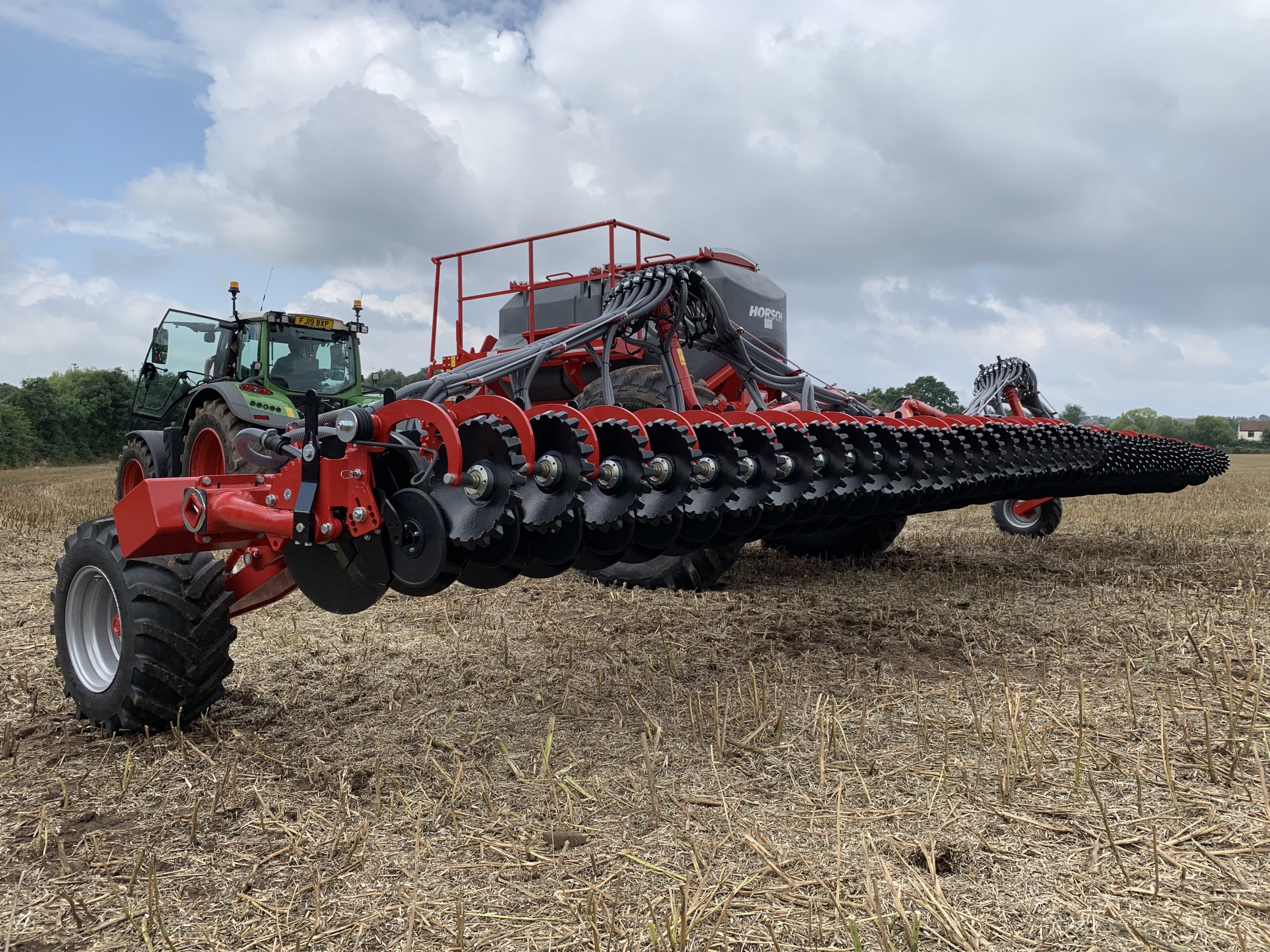
No-till by Numbers
We are often asked how much of the UK’s farmed acres are direct drilled. It isn’t easy to answer exactly, but the easy answer is that it is always increasing. Data seems to suggest between 8% and 12% is no-tilled, but given all the confusion over naming, we are not sure that even this is correct. We’ve heard government official talk about minimum-till, when they mean no-till and trying to explain to the same officials about strip-till, no-till and zero-till leaves you little hope of getting the right data out of any survey.
However, we know it is growing out of being a niche to being “normal”. Although we secretly think some of these no-tillers won’t like being called normal! Seeing this trend, it was very interesting to compare this to data that has just been published in the No-Till Farmer magazine from the 2017 Census of Agriculture in the US. This carried the conclusion:
“Growers are moving away from Intensive tillage in favour of no-till, min-till and cover crops.”
The number behind this certainly show we are still well behind the curve in the UK in terms of adoption.
US Tillage Practices 2017
No-Tillage 104M Acres 37%
Reduced Tillage 97M Acres 35%
Intensive Tillage 80M Acres 28%
These figures do vary considerably by state though as you would imagine with the size of the US and the climatic changes across the country. There are a number of states like Nebraska, Montana, Maryland, Delaware, Tennessee are all well over 40% and in some over 50% of acres are no-tilled. However, conservation tillage numbers are lower than this, but growing at a faster rate.
Given the information we are receiving from the government at the moment, with regards to climate and natural capital, it is likely the appetite for no-till practices will become a lot more palatable to farmers in the UK who will be pushed towards new methods of establishment. Therefore, we expect to see the UK numbers grow considerably over the next 10 years. If you are considering going no-till at the moment, we would lobe to hear from you about why you are considering a new method of establishment.
-

How To Improve Yield And Quality After Applying Your Normal Inputs?
Written by George Hepburn from QLF Agronomy
I have worked with farmers on their inputs for the last 15 years. I worked with Soil Fertility Services for 12 years as a Soil Fertility Advisor, advising many farmers on soil health and nutrition. For the last two years I have worked for QLF Agronomy (based in the US), advising farmers on the virtues of using carbon in biological and conventional farming contexts to feed the microbes and fungi which has shown significant yield, quality and fertility improvements. I am FACTs qualified and I have Certificate in Nutrition Farming from NTS. I have seen biological farming go from muck and mystery to main stream agriculture but there is still much more for us to understand about the soil and more importantly the life within it.
Whilst working with quality proven carbon-based products for the past few years I have seen the results of extensive trials and farm use to improve the crops in the US, UK and EU. I believe that future of farming is biological not chemical and over the next 10 years using carbon with inputs will become a standard procedure as the environmental factors alone, such as improved efficiencies and efficacies of fertiliser and fungicide, better conversion of residue to OM and improved breakdown of chemical residues (e.g. glyphosate) are going to push farmers and policy makers down this route. At the moment there is not enough trial work done in this area by the big agronomy companies, although it is increasing as more farmers and agronomists are switching on to the benefits of a biological system.
You have probably heard that there are more organisms in a teaspoon of active soil than there are people on the planet, there is a very complicated world of interactions going on beneath our feet, which even the top soil scientists admit we know little about. We do, however, know the difference that soil biology makes when it starts working for you. Soil structure improves, water is held when needed and released when not, availability of nutrients improves, it can handle traffic much better and it smells like rich dark chocolate!
One Teaspoon of Healthy Soil
• 75,000 Bacterial Species
• Metres of Fungal Hyphae
• Thousands of Protozoa
• Hundreds of Nematodes
• A Few Micro-Arthropods
• Billions of Living Creatures!!
Farmers working on direct drilling systems often notice very quickly how their soil does improve (in a soil sense of time) but many still do not look after the life in the soil enough to get the best out of it. You can now buy different strains of bacillus bacteria and mycorrhizal fungi and apply them directly to your soil, I have sold these products to farmers and they have worked sometimes but not consistently, and this is the problem there are so many variables you don’t know which ones are affecting your soil life.

I am now of the opinion that if you look after the soil, and feed it with the right foods then the soil life will follow without applying any of the actual bugs. There are certain situations that I can understand applying them for example after potatoes when large amounts of chemicals have been applied alongside a major cultivation program, but most of the time what you actually have to do to get these microbes working for you is quite simple.
Ideally you are looking for the target ratio of 45% mineral, 5% OM, 25% air and 25% water. This is the home that the microbes need to not only live but to thrive in. Microbes will respond to feeding by an increase in number, but you will never get to the optimum levels unless they have the correct surroundings. Air and water in the right ratio is key for stimulating the biology. The best way to check this is with a spade and your senses. Dig in a number of places across the field and feel at how well the spade goes in, how far the roots go down, the smell, number of earthworms (and other visible soil life) and how well residue is breaking down. If you want a point of reference go to an old hedge and dig underneath it. This is the potential of your soil.
Science can help too. Calcium and Magnesium help to define the structure of your soil. High magnesium levels can make the soil quite tight and sticky, not allowing air in and holding on to water. High calcium levels can mean the soil is too open and can’t hold on to water or nutrients. Neither of these situations are good for the soil microbes. This is where an in-depth soil test can be useful looking at the exchangeable nutrients and certain key ratios like Ca:Mg, which can guide you down a soil remediation route. When you have the correct soil structure; which I am seeing more frequently as increasing numbers of farmers do less and less tillage, the next job is to feed the soil or more importantly the microbes and fungi. FYM, compost, lime, cover crops, green manures and digestate are good ‘fertilisers’ as they are all giving the soil life a job to do, but to help them to achieve this they need some energy. Plants do with this by exuding simple sugars, fatty acids and enzymes out through the roots to feed the microbes and we can mimic this by applying similar substances to the soil.
Using a carbon-based (read sugar) product like L-CFB BOOST™ as part of your system can make a big difference, not only are there various types of sugar (sucrose, fructose, glucose and more) which is ideal for feeding the bacteria there is also a more complex food added for both microbes the fungi. Using this type of product alongside your regular applications means that every time you go through the crop you are looking after and feeding these microbes and helping them to perform their role. Do be aware that there are many types of these carbon products getting on the market going from raw beet molasses through to humic acids. Some of these are not suitable for this type of application and a lack of consistent trial data over the years puts a question mark over their benefits. Make sure you ask for independent and farm trial data and look for a good track record of results and ideally farmers that are using it that you can actually talk to.
Getting your soil microbes working for you can mean reduced inputs of fertiliser and fungicides, OM levels building, less run off and erosion, better water holding capacity, improved rooting, better residue breakdown and increased nutrient cycling. All you have to do is give them a stable home and feed them with a quality product little and often.
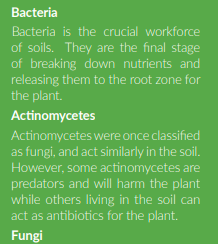
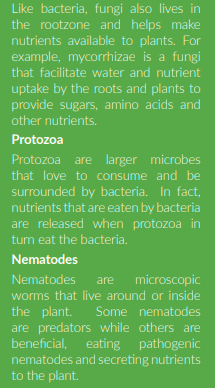
-
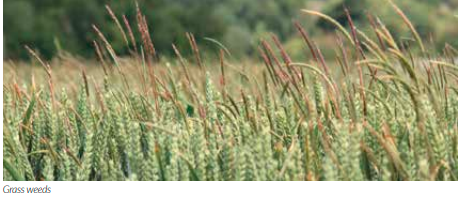
Is Organic No-Till Possible?
Written by Jerry Alford from the Soil Association
There has recently been a lot of interest in the potential of organic no-till and it has been described by some as the holy grail of organic arable farming. It is also something that is of interest to non-organic farms because of the potential to reduce inputs, particularly on less profitable break crops.
Organic arable farming systems have always been built around the use of cover crops, diverse rotations and animals. Building fertility during the rotation for high value crops and also using these covercrops and grass leys as part of weed control strategies. These regenerative phases have always been used to counter the effects of the exploitative phases where crops and tillage remove soil nutrients. Organic regulations (EU Regulations 834/2007, 889/2008 and 1235/2008) prohibit the use of artificial chemicals and fertilisers and support the minimisation of the use of non-renewable resources and off-farm inputs. Put simply, the requirement is for circular economy principles to be followed as far as possible. Many organic farms include grazing livestock enterprises and as with non-organic mixed farms, soil health will benefit. In stockless organic arable systems, clover is grown as part of the rotation and is regularly topped and mulched to build soil fertility.
It is difficult to compare an organic arable farm with a non-organic arable farm because rotations, inputs and even crops may vary. Most organic rotations include legumes because of the fertility value, but very few grow oil seed rape because of its high nutrient demand and pest risk, to both it and following crops. The inclusion of fertility building phases in the rotation is also very different, although this is becoming more widespread in nonorganic systems. Cover crops over winter as green manures are also often part of the rotation. Organic farms can use composts, manures and digestate, subject to certain restrictions, but there are no synthetic nitrogen products approved.
The biggest problem organic farmers face is weeds, particularly grass weeds. Blackgrass can be a problem but the diverse rotations including ploughing, spring cropping and low fertiliser use does seem to reduce its effects in organic systems. In non-blackgrass areas, other weed grasses like annual meadow grass and bromes can reduce yields if allowed to develop. Perennial grass weeds like couch are also a problem although an Innovative Farmers trial has shown positive effects by using buckwheat which has an allelopathic effect as well as a shading effect when the weeds are at their weakest after harvest. Ploughing has become the main weed control mechanism for many organic farmers, with seedbed preparation and cultivations being part of the weed control strategy. However, many organic farmers have looked at using min-till or non-inversion techniques through their rotations to reduce the need to plough. Most would plough 3 times during a 5-6year rotation but finding a way to grow organic crops using a no-till system during the rotation would be a good next step.

The benefits and potential of Conservation Agriculture are plain, but an organic farmer is restricted by the need to generate fertility on farm, the decision not to use chemicals and their customers choosing to buy organically certified products. The Soil Association agrees with the principles of conservation agriculture and in the long term would hope to get to a situation where tillage in organic could be reduced still further and conservation agriculture could take place with reduced or zero herbicide use. Knowing what the issue is the easy bit, finding the answer is the challenge.
So how do we get there?
If we are going to go no-till organically we need to control weeds and cover crops without chemicals. There are already three practices used worldwide, which have been tried in the UK by organic farmers, with varying degrees of success. None have been tried organically into long-term no-till situations.
The most well-known is the crimper roller. Developed by the Rodale institute in America, the ribbed roller crushes the stem of plants. The rolled plants then act as a weed controlling and moisture retaining mulch which also returns nutrients and organic matter into the soil. To work properly the crop being rolled must be an annual and at anthesis (early flowering). In America the most common crop crimped is rye which is at the correct stage when Soya and Maize are being drilled. In the UK the correct growth stage comes too late for UK cropping. The allelopathic effects of the rye may also make it unsuitable for small seeds like wheat. In an organic rotation, there is the potential to grow rye as a cover crop and then crimp and drill vetches during the fertility building phase. This second cover can then be crimped and will supply nitrogen to an autumn drilled cereal. This avoids the need to plough out a grass ley which itself can become a source of weeds.
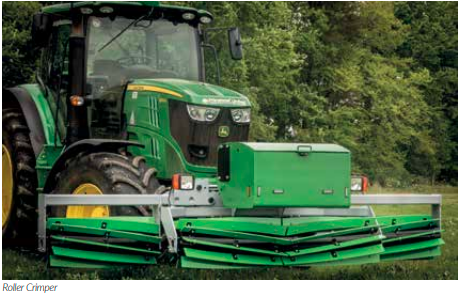
The second technique is to drill a crop in the winter into a frost susceptible cover crop such as buck wheat, berseem clover, phacelia and mustard. This will provide a mulch to the next crop as well as nutrient recycling. Smaller seeded plants may not work in this situation because they are less competitive as seedlings, but it has been used for beans. There is a potential problem if there is a mild winter because any cover crop plants which produce seed could create a weed problem in later crops so some form of management may be necessary. Grazing with livestock could be an option because cereal and OSR plants will regrow after grazing. As part of an Innovative Farmers trial on alternatives to glyphosate a group of farmers used rollers on cover crops during a frost to investigate whether they would be an option and did show some success, which would allow late winter drilling where ground conditions allow.
A third option is to use a permanent understorey and drill into this. Similar to pasture cropping which drills into permanent pasture this form of bicropping would use a clover understorey to provide both cover and fertility to the growing crop. This technique has been used in non-organic situations where the clover is either grazed hard or sprayed with glyphosate at low rate and crops drilled into this. Clover needs soil temperatures of above 10 degrees to grow and so is not very competitive against a winter/early spring sown crop but could be an issue at harvest if the crop is not competitive. It is important to choose a smaller leaved and low growing variety of clover. Nitrogen will be released when the clover is cut and so some method of topping or crimping between rows would release nitrogen to the crop. After harvest the clover could be mulched, cut for silage or grazed prior to the field being redrilled in the autumn/winter. In theory any crop which is competitive could be drilled into this permanent cover which will self-seed and spread to maintain a competitive mulch. Possible problems come during later years if the clover grows too quickly or competes for moisture with the germinating crop plants.

Innovative Farmers are setting up a trial looking at this using white clover as a cover. To be held on long-term no-till farms and an organic farm, the plan is to plant a white clover cover crop in the summer after harvest and drill a spring crop for 2020 harvest. This can then be continued into 2021 and there is the possibly to also look at techniques to manage nitrogen release from the clover. If this proves effective it could be possible to have a rotation including cash crops every year with a permanent cover crop in the understorey.
Trying to fit these techniques into either organic or non-organic systems in the UK is tricky. Our maritime climate suits grass and weed growth, particularly during the summer and the current variable weather patterns lead to late weed flushes. If we had European type weather patterns with dry summers and hard winter frosts, it would be easier to do. As a result, we need to look at what cover crops and cash crop rotations fit best into the UK climate and farming systems. This research must also look at profitability and costs of systems as much as at inputs and this research needs to be done at both farm and regional level to move away from a one size fits all scenario. Both organic and non-organic farms would benefit from sharing this knowledge and applying those practices which they can borrow from each other or which can be adapted to fit.
Please contract the Soil Association on 0300 330 0100 for more information or advice.

-
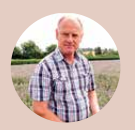
Farmer Focus – Simon Cowell
An Alternative System of Crop Nutrition

Back in 1894, Julius Hensel wrote Bread From Stones which proposed the idea that all the minerals plants need are present in rocks. He used the annual flooding of farmland beside the River Nile as an example, where the soil’s fertility was maintained for thousands of years by sediment washed down from mountains to the South. Hensel compared this to the soil of many other civilisations which gradually lost its ability to grow crops and so, after a few hundred years, became deserts. He thought that there was no need for animal manure to maintain fertility, and only a light dusting of ground rock dust was needed.
Edward H Faulkner wrote an equally controversial book Plowman’s Folly in 1943, a great read for all No-Tillers. As well as arguing for minimal soil disturbance, he thought that all mineral nutrients originally came from the base material that topsoil is made of. He suggested that it is the same all over the world, whether the underlying base is limestone, granite, sand, clay, chalk or anything else, and that there was no need to apply fertilisers such as Phosphate or Potash.
Even in Faulkner’s time, little was known about soil biology and so he and Hensel had to guess how the minerals were being made available to plants. Hensel thought that the Carbon Dioxide released from plant roots was acidic enough to dissolve rock dust, while Faulkner believed that acids were produced during the process of breaking down organic matter such as dead roots and crop residues. We now know that turning limestone, sand, clay etc into fertile topsoil is a biological process in which many types of bacteria use acidic compounds to break down the base material. This process releases mineral nutrients which are then made available to growing plants.
About twenty years ago someone told me about a simple phenomenon which formed the basis of everything I have done in farming ever since. If you test and measure for available nutrients in both a given area of soil and in a quantity of farm yard manure, (and the manure is then applied to that area), when the soil is tested again after a few weeks, the total nutrients available will be substantially higher than the sum of the two original tests. In other words, the manure stimulates the soil biology to release otherwise unavailable soil nutrients.
I did some total soil mineral nutrient tests using very strong acids which evidenced tons of tied up P, K and Mg, and hundreds of kilograms of B, Mn, Cu and Zn in the top four inches. Some crop roots go down to six feet meaning the amount of existing nutrients in the top four inches can be multiplied 10 or 15 times; therefore, I have an unlimited supply of soil based mineral nutrients in my soil. Not having any manure available, the soil biology needed to be stimulated by other means. Biological Stimulants are widely available nowadays, but back then it was a matter of spraying on molasses. This idea has quickly advanced into more complex mixtures of humic and fulvic acids, soil conditioners and other soil goodies and now forms the basis of my policy of not applying any Phosphate or Potash fertilisers. Due to continuous no-till, my crops now have unheard of levels of mycorrhizal root colonisation, at 80% on wheat rather than the typical value of 30%, which increases each plant’s root rhizosphere by a thousand times. The plants full nutrient requirements are being met by these fungi, (and in the correct ratios), rather than having to accept what ever is in solution in the water they take up.
As always with these things, it is worth referring to what can happen in non-farmed environments. Although a lawn is not natural, keeping the grass short the only human interference; however, I don’t think anyone has ever claimed that removing cuttings makes any difference to how much it grows compared to mulching them down. If it rains, the lawn needs cutting, and there is nothing you can do about it, whether the nutrients are recycled or not. Trees are another great example, in many gardens and parks, fallen leaves are picked up, year in year out. This means that the nutrients are not being recycled as they would in a forest, so every Spring the trees must work with soil biology to extract fresh minerals from the ground to grow new leaves. In the extreme, there are thousands and thousands of perfectly healthy trees growing out of pavements in towns and cities. How can they keep on growing for hundreds of years without recycling nutrients in their leaves when their roots don’t have much access to air or rainfall?
It seems to me that all higher successional plants growing in the absence of recycled nutrients or fertilisers are perfectly capable of extracting all they need from the infinite store underground. I am sure this all seems impossible to mainstream farmers and advisers who test for soluble nutrients and convert percentages into “indices” which are then assumed to represent a level of stored nutrients. Fertiliser is then applied to make up for what has been removed by their harvested crops. In my opinion this system is wrong and I have now come to the conclusion that I do not want my indices above 1; I want all my nutrients tied up in the organic matter or clay where they can’t leach away but are easily available to the crops.
It is quite normal to question yourself when doing something different, and I too have gone through periods when I have wondered if a little phosphate fertiliser, even as a starter, might help. However, when combining wheat crops a few weeks ago which were yielding over 10 tonnes/hectare, I did allow myself a little congratulatory smile because I really was proving that the soil can provide all a crop needs.
-
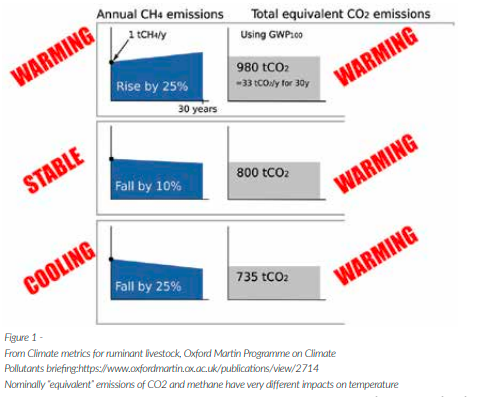
How To Farm Sustainably
Just after Groundswell in June, the Sustainable Food Trust held an event at Fir Farm titled “Farming and Climate Change: Towards net Zero Carbon Emissions.” Climate change and the ability of farming to be #TheSolution has been in the farming media a lot recently and there were a number of mainstream journalists at the event who where hopefully getting a lot of exposure to farming ability to be part of solving climate change around the world.
Opening the speaking was Charles Massy on regenerative farming. This certainly set a tone for the meeting and his thoughts were not universally appreciated by this audience. However, this was a very different audience than you see at Groundswell and so getting the message across about sustainability, climate change and soil health to a different audience can only be good. If you heard Charles speak at Groundswell you will know how passionate he is about creating balance in any environment. His book is well worth reading and is referenced in the “what to read” section later in this issue.
The event was inspired by Minette Batters pledge to make farming netzero by 2040, 10 years ahead of the government 2050 deadline. Minette herself spoke at the event. Much talk was given to livestock and pasture fed approaches to sustainability. Certainly, introducing pasture fed livestock into your rotations has been shown to be very beneficial for your soils. There was however no time given to grazing cereals, which also has potential to benefit farmers and soils. However we certainly don’t need a “Cereals Grazed Livestock Association” to join as well as pasture fed, so we aren’t sure who will promote it.
All about carbon
While the title of the event was about carbon neutral farming, one of the most interesting sections (not necessarily for arable farmers) was from Professor Myles Allen of Oxford University. The government and NFU pledge relate to both Nitrous Oxide and Methane as well as CO2. To stop the effect of climate warming by CO2 we have to simply stop producing more C02. So we need to reduce net output to zero. Tricky on a number of fronts, as we exhale it and we have a habit of driving, flying and avid consumerism. Crops, grass, hedges and trees do like to consume CO2 though in vast amounts. So farmers have a distinct advantage here.

But methane is the interesting one. To halt its effect on global warming, you don’t need to reduce methane emissions to zero. In fact a 10% reduction will do. Figure 1 shows the situation based on how a 25% increase, a 10% decease and a 25% decrease in both CO2 and Methane would effect the way they warm or cool the environment. This is great news for any livestock farmers, as the solutions to reduce methane production already exist. We already have feed additives than can reduce production. You have methane collection systems. You can then burn collected methane for energy production or even run your tractors on methane. While the costs of these are still high, they do exist and the effective “net zero” for methane is actually 90% of today’s production and can easily be achieved by the NFUs goal of 2040. Therefore if you are a livestock farmer your path to reaching net zero by 2040 doesn’t seem that complicated. That said, this move will still have a massive effect on the price on meat from UK production.
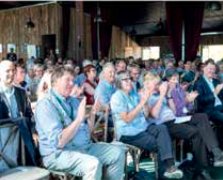
Ironically, this is the exact opposite of the picture presented by the national media, where meat is taking a bashing at the moment. Not so great for combinable crops farmers though who feed the vegan community in the UK. If you have time, please do watch the video of Professor Allen’s presentation by clicking on the QR Code below and going to 16 minutes in. The summary here does not do it justice and shows how livestock farming can also be part of the solution to global climate change.
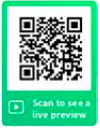
What was missing?
The event was brilliant, any opportunity that allows you to learn is always a good use of a day. There was massive disagreement in the audience when it was suggested glyphosate should be banned. Members of the public who were attending stood up and stated that glyphosate in food was causing harm. So regardless of what we think as farmers or know from research we have read, “glyphosate” which seems to be the word the public uses for all crop protection products, is “bad”. The fact that glyphosate allows farmers to massively reduce the amount of fossil fuels they burn needs to be stressed to the public. It is a lot easier to be a sustainable farmer with glyphosate than without.
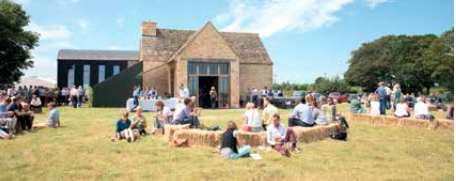
As you can imagine, we were hoping to hear lots about direct drilling, no-till farming, cover crops and everything else you read in this magazine. This was however in the great part missing. This was mostly because of the livestock and organic basis of the event. You would think these reduced tillage practices become almost essential for a conventional farmer who want to grow crops sustainably in 2040. There was also very little talk about reduction of synthetic fertilizers. A quote from an attendee at lunchtime pretty much summed it up:
“When is someone going to break the news to the average NFU member, that Minette’s pledge means they are going to have to stop ploughing and stop using synthetic fertilizers”
There is a lot to agree with in this statement and why the target of 2040? Gail Bradbrook of the Extinction rebellion movement also spoke at the event. Gail has asked that 2025 should be the deadline for net-zero emissions in terms of climate change. It’s a good question really for agriculture. If we just stopped using fert and stopped ploughing next year, this is certainly achievable. The major problems are of course that yields would be reduced and therefore we would have to buy in more food from abroad. So, while UK farmers will be doing our bit, I think consumer trends would mean that the average carbon footprint of a shopping basket would go up if we took this approach as a country. Secondly, we are not convinced that consumers want the price increase that would inevitably come with this production method. Thirdly, to be sustainable farms also have to be profitable and the above situation does not seem financially sustainable at the moment. However, maybe that’s going to change.
Carbon Farming
Along with Dieter Helm’s views on Natural capital that you can read about later in this issue. The concept of carbon farming was mentioned. Carbon currently sells for £17 a ton on the bond market. We are not totally sure where this carbon is bought from, but you can buy carbon credits to offset your carbon footprint. Elton John did just this recently to offset Prince Harry’s flight by private jet. So there is a market for it. Therefore if you farm in a carbon negative way, with limited inputs and low fuel usage and therefore have a balance of carbon in terms of your own footprint you can sell this (in theory). So if you can be 1000 tons of carbon in credit you can sell this for £17k a year. Sounds like a nice way for a farm to supplement its income and will be interesting to see how this market evolves. We would think that given this potential income stream, Direct Driller’s readers could create a very large pool of carbon to sell together to the market. Of course, you need to know your own carbon footprint and you would need to do the maths on whether reducing inputs (and therefore yield) would give you a saleable carbon footprint that outweighs the loss of yield it would cause. The future in this respect is going to be interesting.

We will let you know when the Sustainable Food Trust hold their next event as it is well worth a day of your time to understand more about our industry and how it is going to change over the next 30 years to go from a net emitter of green house gases to becoming a net sequestrator of green house gases. This is a massive opportunity for farming.

-
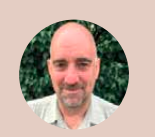
Farmer Focus – Tim Parton

Managing 300ha in South Staffordshire on sandy/clay loam soils, I first became aware of how important soil was in the mid-90s. Presently, nothing in my mind is more important than our soil. It provides the population with food, air and clean water through plants and trees, that keep us nourished and sustained in life. Additionally, I noticed how crop yields had plateaued, whilst I was having to apply more nitrogen in order to get the same results. I knew something had to change; it is believed that 1kg of unused nitrogen can destroy 100kg of carbon in the soil. I knew that I had to replace the carbon that had been depleted over the last 60 years; the question was, how I was going to do it. It began for me in 2010 in using a strip till drill, which worked really well. I never had a yield drop, only an increase; this was also a fantastic way for me to start and get my head around moving much less soil, which brought the change to a no-till drill.
In 2015 in the form of a 750a, never had I seen a drill position seed so accurately before, but the drill did lack some features which I felt it needed. I wanted to be able to place fertiliser / biology down next to the seed; this is vital to get the best out of the biology brew, which is aimed to fix nitrogen and release phosphate and also fight off fungal infection, of which I have had some fantastic results.
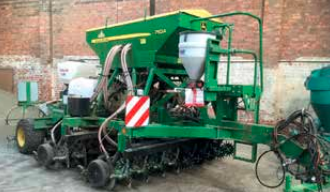
The options needed were another hopper for companion cropping or applying slug pellets. This was achieved by blowing the seed into the venturi. Also I wanted to be able to apply mycorrhizal fungi when sowing grass on a short term ley, (which I make into haylage for horse feed). This is a fantastic way to build fungi as the crop is down for 4-5 years and in addition it also controls grass weeds. Furthermore, I also wanted to be able to broadcast at the rear of the drill to give me even more options, such as applying Avadex or Boron granules.
The next change to consider was rotation, as now I not only grow what is profitable, but also what is best for the individual field. Since I am now farming for regeneration of soil for future generations, I feel that this is an important issue; to leave the soil in a regenerative cycle moving forward for generations to come and repair some of the damage done in the past. I still have OSR in the rotation, but on a 6-year rotation, as I feel this is still a good break crop for the farm that is profitable.
I haven’t used insecticides for 5 years and don’t really have a problem with csfb (I hope I have not jinxed myself by saying that). With dd crops I always get a higher brix reading (I recommend everybody to purchase a refractometer) which means that the crops grown just don’t show up on aphids’ radar but I am still out checking on a regular basis. I feel once you get off the insecticide hamster wheel then all the predators come back and begin to do the job for which they were intended. Nature to me has all the answers; we may not have discovered them yet, but they are there. I may also grow W Wheat, W/S barley W/S oats, W/S Beans, Lupins and Grass.
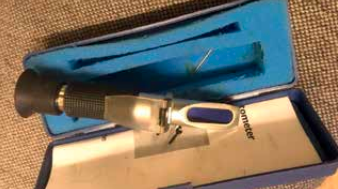
Autumn herbicides are no longer used, as all crops are drilled on the green into cover, this also reduces/eliminates the need for slug pellets. The rotation is also split w/s cropping in order to allow growing a cover crop through the mid-tier scheme which allows me to be able to put carbon back into the soil through photosynthesis and also keep biology alive within the soil whilst also getting paid for the privilege. Cover crops are then destroyed either by grazing or rolling on a frost, but it does need to be – 4o C when rolling in my experience in order to get the shatter effect, which breaks the crop down into manageable pieces enabling worms to incorporate it into the soil. I am always trying to cut down on the need for glyphosate and this is one way that has definitely worked.
The other approach for the future will be some trials with a crimper roller, as I firmly believe and have found, that as long as you keep the soil covered then weeds have no need to germinate hence, we have not the need for herbicides. People often said to me that as I disturb less soil, I would reduce my weed bank in time. I now believe this is not relevant; I want and need my seed bank as an indicator of what is actually happening within the soil, so if I do not keep the soil covered, the soil will take care of itself and produce plants to protect it. I no longer have problems with brome grass these days (hope I haven’t jinxed myself by exclaiming that!) as my soil health has got a lot better I may get the odd plant which is just a reminder of what I am trying to achieve to keep me on track and not lose my focus on where I am heading.

Cutting down on fungicides has also been one of my aims as some can be damaging to fungi within the soil and take yield if they are not needed. I have managed to grow wheat and barley without fungicides with a healthy soil and have brewed up microbes to eat fungi attacks such as fusarium. I like to rely on biology first and keep fungicides as a backup when needed. We still have such a lot to learn from biology and I still feel nature has all the answers especially once we stop relying on synthetic fertilisers, but this system does have its challenges and as I always say when I am giving a talk, one of the most important parts of this system is becoming a farmer again and actually getting out into crops/soil and understanding what is really going on. Regenerative farming has reignited my passion for agriculture, as I totally believe we are what we eat and a healthy soil provides healthy food which results in healthy people.

This season I haven’t applied any T0 fungicides to my wheat. Instead I have corrected any nutritional imbalances using Aviva fertiliser products. I am able to have a mixture of nutrients made up to suit my plant requirements. This is achieved from tissue analysis, brix, potassium and phosphorus readings. The nutrient mix varies from year to year, since weather conditions always vary, in turn causing the biology to behave differently within the soil. When the biology is not able to give the plant what it needs, I intervene. By growing healthy plants from healthy soils I have found I can farm without fungicides, but always like to have them as a backup. I did use some, (a fungicide at T1) on some of my wheat, because at the time of making the decision the weather looked unsettled (good old weather forecast) but the untreated did well and with the weather settled, I used brewed biology and orange oil as a T2.

Notice from the photos the untreated areas did have severe rust which was a nice way to prove that the treatment had done the job, also giving me even more confidence moving forward, which concluded with a biological T3. I feel going forward as farmers, fungicides’ efficacy will continue to reduce and biology will take the lead as it is far more environmentally friendly, which is what our customers will demand going forward but also what I want as a land manager. Soil is our past, present and our future, so as a world community, we must take good care of it if we want to thrive as a species. I wish every person on the planet were compelled to read “Dirt the Erosion of Civilisations”, by David Montgomery. Soil degeneration has happened before and in my mind, it is the fool that doesn’t learn from past mistakes. Recently I have also started to monitor air quality on the farm by looking at which species of lichens are growing around the farm and using them as bio-indicators. As the pictures show, I have moved away from the nitrogen loving species to the more intermediate types (flavoparmelia and parmelia). Once again I am reassured that nature and I are regenerating farming in the right direction.

-

Herbicide Resistance Targeted By New Oxford Tech Firm MOA Technology
Weed resistance is becoming a major issue for crop production. The International Survey of Herbicide Resistant Weeds
collates information from researchers worldwide on the spread of weed resistance. Today resistance is present in more
than 250 weed species infesting nearly 100 crops and affecting 23 of the 26 known herbicide modes of action. Looking
at the highest selling herbicides globally many have resistance issues. Glyphosate is the most prominent as it is such an
important product and used so widely, and often, but resistance issues affect most herbicides to some degree – which is
why discovery of new modes of action is so criticalWritten by Direct Driller editor, Mike Donovan.
Frequent application of a herbicide or herbicides with the same mode of action exerts selection pressure on weed populations. If surviving weeds are fit enough to reproduce and establish a population then resistance arises. The root of the problem is the difficulty in finding new herbicide modes of action.
Herbicides accounted for more than 40% of the global market for crop and non-crop pesticides worth $64 billion in 2018 Selective herbicides, such as 2,4-D and MCPA invented in the 1940s started the move away from various forms of hand and mechanical weeding, yet still continue in many developing countries. It is increasingly difficult to find enough labour at the right time and at affordable wages to manually control weeds. Problems are exacerbated by the movement of people away from the countryside to work in cities. Often it falls to women and children to do the backbreaking work of hoeing, slashing or pulling weeds.

Having cleared a field, the job has to be repeated in just a short space of time as new flushes of weeds emerge. In many developing countries, herbicides free women, in particular, to feed, educate and care for their children. Hand weeding one hectare of maize can take 250 person-hours of work, while it can take just two hours for one person to apply herbicide from a knapsack sprayer to the same crop area. With weed control taking a fraction of the time needed previously, herbicides allow smallholders to supplement their income from additional employment.
From the 1960s, non-selective herbicides (paraquat from the 1960s and glyphosate from the 1970s), enabled the adoption of no-till (direct drilling; zero tillage) and other reduced cultivation systems for crop production to be established. If weeds are removed by herbicides before planting, then there is no need to plough to bury weeds. No-till systems can increase yields when crops are appropriately established and have many environmental and economic benefits.
The benefits of no-till systems, include
1. reduced labour;
2. reduction in soil erosion;
3. water conservation;
4. reduced fuel and energy used;
5. reduced greenhouse gas emissions;
6. greater biodiversity.
Combating climate change is especially topical. Ploughing aerates the soil excessively, causing the oxidation of organic matter. Not only does this destroy good soil structure (built-up after rotational pasture, for example), but it releases large amounts of carbon dioxide. Spraying a herbicide to burn down weeds before planting in a no-till system can reduce emissions of CO2 by more than 80%.
Fundamental research at Oxford University
Research scientists have developed new methods of developing the next generation of herbicides. The research is a new spin-off from the university in the shape of MoA Technology, launched to confront the global herbicide resistance issue. The company has secured a £6.3 million Series A funding round. MoA Technology will use the funding to develop its unique crop protection discovery platforms.
The research is out of Oxford University’s Plant Sciences Department from ground-breaking research by co-founders Professor Liam Dolan FRS, and Dr Clement Champion. The company has developed its own discovery platform and is focused on the next generation of sustainable herbicides which have new modes of action from both natural and synthetic chemistry. MoA Technology has developed three proprietary platforms: MoA Galaxy, MoA Target and MoA Select.
Each platform is powerful in its own right, but when used in combination, offer the opportunity to revolutionise the herbicide discovery process and critically identify new, effective and environmentallysustainable herbicides. The platforms are based upon a unique combination of genetics, trait analysis and data analytics. The funding round into MoA was coled by Oxford Sciences Innovation, the world’s largest university venture fund, and Parkwalk Advisors, the largest EIS growth fund manager focused on university spinouts. Oxford University Innovation, the University’s innovation arm, assisted in spinning the company out in 2018.
Liam Dolan, Sherardian Professor of Botany at the Department of Plant Sciences, Oxford University, said: “In recent years industry has moved from high throughput screening to lower throughput in-vivo plant screening but neither method has been successful in uncovering marketable herbicides that have new modes of action. We have redesigned the discovery process in its entirety. Not only do we focus on identifying new potential modes of action at the outset, our platform combines in-vivo screening with a high throughput capability that we believe is a first in this industry. Early results are extremely promising”. Hadyn Parry, Chairman at MoA Technology, added: “Weeds are now a greater threat to crop yields than at any time in recent decades. New solutions are urgently needed. Raising £6m at this stage in the company’s development is a real testament to the strength of the company’s prospects.”

Why is herbicide discovery difficult?
MoA suggests four reasons why so few new herbicides have been developed in recent years. The first is that the creation of glyshosate tolerant crops has meant a lack of incentive to produce genuine weed killers. Second, as agri-chem companies like Bayer and Monsanto merge, so there are fewer companies searching for new formulations. Third, the dramatic escalation of R&D costs has reduced company research as the returns are difficult to assess. Lastly, regulatory hurdles have become ever more stringent. In addition, in the past, leads were selected from whole-plant screens on the basis of their symptomology by expert herbicide biologists.
The move to HTS in vitro screens effectively pre-screened the input into whole plant tests, lessening the probability of observing novel symptomology. Serendipity has also played a role. Chance observations from Nature have sometimes provided the inspiration or starting points for very successful crop protection active ingredients. This may prove fruitful in future utilising new technologies to identify novel modes of action with potentially attractive commercial profiles of activity, physico-chemical, toxicological and eco-toxicological properties; and to identify the essential parts of often highly complex molecules.
The MoA system
MoA Technology has three innovative herbicide discovery platforms based on an in vivo plant model designed to pinpoint and elucidate new modes of action, essential to developing safe and effective active ingredients to control weeds. The platforms need only submicrogram test samples, ideal for screening chemical libraries not previously screened by conventional methods requiring high quantities, or those from which traditional highthroughput screening failed to detect hits. Each molecule tested generates a data-rich ‘fingerprint’. Artificial intelligence systems pick out hits with novel modes of action. Used together in sequence, MoA platforms can quickly and costeffectively find streams of herbicidally active chemicals structurally unrelated to the original hits and having the newly defined mode of action.
Bringing a new herbicide to market
This can take over 10 years. There are many stages involved which can be condensed into three main phases:
• Lab phase – discover new compounds and modes of action
• Greenhouse phase – test on weeds, test within crops
• Field phase – testing outdoors in any different environments
• The regulatory side of safety, environmental profile, application rates and options, operator safety are all ongoing throughout out the process
• Safety and environmental factors have been at the forefront of regulatory improvements over the years. Any product coming to market must go through the appropriate regulatory approval process in each country.
MoA TARGET™ can identify the precise target protein, associated with a new mode of action. The platform uses an in vivo plant-based genomic patented process.
Knowledge of the target protein is important for two reasons: First, if the protein is found only in plants this predicts that the mode of action should be safe to humans and the environment. Second, this knowledge also assists in the discovery of more effective analogues for this mode of action. Overall, the information from MoA TARGET™guides researchers to novel, safer, more sustainable and effective herbicide active ingredients.
MoA GALAXY™ allows the simultaneous discovery of new herbicidally active chemicals and a prediction of the novelty of their modes of action. Using groundbreaking research into plant biology, MoA Technology developed MoA GALAXY™, a unique, proprietary, in vivo HTS platform for finding new herbicides. The wide range of herbicidal activity data produced is digitised and exploited by artificial intelligence. This provides high quality predictive information on both herbicidal activity and mode of action at a scale, speed and cost previously unavailable.
Comparing symptomology ‘fingerprints’ of known herbicides and test molecules, MoA GALAXY™ rapidly identifies known modes of action, and reveals new ones. Data visualisation creates a ‘star map’ showing clusters of known modes of action with ‘lone stars’ as outliers indicating new ones. Hence, MoA GALAXY™ ! Unlike in vitro screens, MoA GALAXY™ in vivo screens whether a molecule crosses the cell membrane to have its herbicidal effect. This makes for high quality hits and provides a strong indication of their whole-plant activity.

Features of Galaxy
• High content imaging coupled with artificial intelligence leading to novel herbicidal starting points with unprecedented level of insights at the earliest stage of discovery
• Fast turnaround: with the ability to test tens of thousands of samples per month for both herbicidal activity and corresponding mode of action
• Very small amounts of test chemical required, which allows the use of dilute liquid solutions
MoA SELECT™ can discover other herbicidal active molecules utilising knowledge from MoA Galaxy™ and MoA Target™. Knowing the original lead’s mode of action and its associated target protein, MoA SELECT™ points to other chemistries with the same mode of action. These may be analogues or totally unrelated. At this stage, promising leads can be progressed for glasshouse and field testing. MoA SELECT™can also provide both new and structurally unrelated, diverse starting points for further traditional lead optimisation. This allows broad patent coverage of the new area of chemistry to be quickly and efficiently established.
Headquarters: MoA Technology Ltd.,
Innovation Building, Roosevelt Drive,
Oxford, OX3 7FZ, UK -

Cover Crop Crossroads
By Phil Jarvis, head of farming at the GWCT Allerton Project, as based on information found on Agricology (www.agricology.co.uk ).
Life is all about choices, some turn out well and others can fire a whole load of challenges your way. The same is true as
we develop our agricultural businesses from dipping a toe in the water to a new enterprise, or financially committing time, money and energy to turn opportunity into something more tangible.Over the last 5 or so years, many growers have either read about, dabbled with, or fully integrated cover crops into their arable and livestock businesses. We’re all aware of the soil health benefits of organic matter, storing nutrients, reducing erosion and helping structuring soil. However, cover crops do present challenges which can trip up or turn growers away from such an agroecological approach.
I’m going to concentrate on my thought processes at Loddington…
Firstly, cover crops are part of my drive to improve the resilience of the soils during wet and dry periods of weather. They are part of a system in which I am trying to disturb the soil as little as possible, keep as much of my soil as possible armoured against the wind, rain and sun, and it’s based on an ever-expanding rotation. With such a philosophy, on my heavy Leicestershire soils, drainage is key. If you are going to pursue reduced cultivations, you have to make sure your land drains well. This is certainly an area I need to improve upon.
Soil needs its mineral and water components, but air allows the soil to breathe and its fauna and flora to flourish. There are many other factors which influence this holistic picture and they all meet together like the ‘hustle and bustle’ of a busy crossroad. So from one direction comes my rotation and cultivation strategy, from another route come my fertiliser and plant protection options. The course I eventually end up having to travel upon is one that will have to be financially viable; no matter how attractive the ideology sounds.
My options…
So at this congested junction sits cover, catch, and companion cropping. Much of the other paths are not new to me, but continuous cover is gathering momentum and maximising the benefits, whilst minimising the negatives is paramount. I have to choose crops that will not encourage too many pest and diseases (encouraging none is virtually impossible!). I want to establish them with as little compaction as possible so I choose to put them in with a seeder unit attached to my low disturbance sub-soiler and not roll them afterwards, relying on the subsoiler’s packer. Oats, phacelia with only a smattering of oil radish works well. Vetches can be expensive and air seeder fans are often not robust enough to blow them through the air seeder distribution head.
I can grow crops which are not frosttolerant (buckwheat and mustard) that might negate my need to spray them off, but my un-friendly blackgrass community continues to vie for my attention and the sprayer beckons. Topping, ploughing and grazing are all alternatives. Some of these destruction methods require lots of diesel and horsepower and can undo much of the structuring work I’m aiming for. Sheep would be my four-legged animal of choice, if glyphosate is not part of your system.

My chllenges…
Establishing the following crop raises another conundrum… Many growers like to spray crops off early in the year, allowing the biomass to collapse which ultimately leads to better drilling conditions. I struggle to consistently find a weather window in early January but they are about! Doing this keeps the soil cover but I think it reduces any allelopathy effect on following crops.

The drilling operation is performed by my 4m Dale Eco-drill and, depending on conditions, I usually roll. I always start the first day of spring drilling mid-morning when the dew has abated, otherwise it can be a frustrating few hours getting the drill and the operator to deal with fresh, wet, cover crops. It always goes better on day two – whatever time I venture out of the farmhouse.

My biggest challenges are blackgrass and slugs, so growing cover crops before spring crops is good, and reducing the brassica content helps fight the pesky molluscs. I’m told carabid beetles have an appetite for field slugs, so I’m investigating beetle habitat next.

So there are a lot of choices to be made at this crossroads, my only bit of advice is take one of the pathways and don’t let indecision get you down. If it goes wrong, learn from it and move on, if it goes right…. get down the pub and tell everyone about it!

Visit www.agricology.co.uk to view other blogs, videos, podcasts, research projects and resources on growing and managing cover crops. Agricology is an independent collaboration of over 20 of the UKs leading farming organisations and provides a platform for farmers and researchers to share knowledge and experience on agroecological farming practices; online and in the field. Subscribe to the newsletter or follow on social media @agricology to share your questions and experiences with the Agricology community.


-
Remote Weather Data? Make Use Of A ‘Hidden’ Network…
We’re all becoming more and more familiar with the ‘internet of things’ – the burgeoning range of sensor-laden devices that collect, exchange and analyse information through the internet
Domestically, IoT (as it’s commonly referred to) is big business, with wellknown brands such as Alexa, Nest, Ring, Hive and even children’s toys taking advantage of IoT to provide services and features that only a few years ago would have bordered on science fiction. Agriculture, despite or perhaps because of its recognition as one of the least-digitised industries, hasn’t escaped the IoT influence. Everyone from start-ups to established multinationals has scrambled to take advantage of the new-found availability of low-cost sensors (to collect data), advances in artificial intelligence (to analyse the data) and of course the ubiquitous algorithm. Through IoT, agritech is becoming big business in its own right.
But of course, IoT devices demand constant connectivity. In a domestic or urban setting, that’s rarely a problem. Figures from the UK’s Office for National Statistics reveal that 90% of British homes enjoy an internet connection, while Ofcom reports that 4G coverage in urban areas is around 97%.
It’s one crucial aspect that is often overlooked in making the transition to agriculture. “Too often there’s the assumption that the countryside – the farmer’s place of work – has access to the same quality mobile phone signal as towns and cities,” says Martin Ducroquet, the cofounder of Sencrop, a provider of smart, affordable on-farm weather stations, which transmit superlocalised, from-the-field weather data to the cloud every 15 minutes.
“Anyone who works in the field on a regular basis will know that’s not the case,” he laughs. “The official line from Ofcom is that less than twothirds of rural areas have access to a 4G signal, while even fixed broadband often remains dismally slow in rural England. Data transmission is awkward and unreliable.
“What’s more, connecting with a mobile network requires some kind of a subscription for a SIM card. If you can’t connect your IoT devices to wi-fi, then you need individual cards and monthly subscriptions for each and every IoT device you intend to operate.”
Working to perfect their innovative ag-weather station, which can record windspeed, rainfall, temperature, humidity, and leaf wetness, Martin and his co-founder, Michael Bruniaux, decided the SIM card route to connectivity was a dead-end. “From the beginning, we made one of Sencrop’s central features its ability to connect, peer-to-peer, with other stations in the vicinity. It’s a collaborative approach. At Sencrop, in conjunction with our 10,000 users, we are building the largest onfarm weather network in the UK and Europe.
“With weather data, it’s a case of ‘the more, the merrier’. The more data points we have to analyse, the more accurate we can be in the advice that’s provided to users through the app and interface.
“We wanted to pitch the units at a price point which would encourage farmers to buy more than one unit, to be able to take advantage of this ultra-localised technology. But if multiple stations meant multiple SIM cards to manage and pay for, we felt that would be a disincentive to realising the system’s full potential.
“Moreover, we thought that users would – perhaps rightly – be wary of a system that was reliant on mobile phone signal, when many of those users would know from experience how patchy and unreliable a rural mobile signal can be. “We thought there had to be a better way to provide connectivity,” he says, “and that was when we set our sights on Sigfox.”
Sigfox is a low-powered, longrange radio network – but few people have heard of it. Described as a 0G network, and superficially similar to a mobile phone signal, the network relies on a series of base stations. But because of its long range, it requires fewer masts. There are more than 1,000 Sigfox base stations in the UK, compared to between 30,000 and 40,000 mobile phone masts – yet Sigfox achieves nationwide coverage of 95%. Created specifically to deal with the IoT boom, Sigfox now boasts more than 6 million connected devices – from urban streetlights to water meters.
The figure’s expected to keep rising as more IoT developers opt for what looks likely to become an industry standard: trials with satellite coverage begin later this year. The technology communicates in a part of the radio spectrum reserved for ‘Industrial, Scientific and Medical’ devices, using a wide-reaching signal that isn’t blocked by solid objects and can even reach underground. Sigfox masts ‘listen’ for messages from enabled devices, without needing to establish a network – features which reduce both energy consumption and the complexity of the connected device.
“Sigfox communication is simple, energy efficient and low-cost,” notes Martin, “three attributes which suited us and our development devices perfectly.”
Simplicity means fewer complex parts in the device, Martin points out, reducing cost of production while allowing easy setup and configuration. “It’s what allows us to turn out a professional-quality ag-weather station with 24/7 accessibility for £399.”
Meanwhile, lower energy consumption causes less drain on batteries. “Ours last for more than three years,” Martin points out, “despite transmitting data every 15 minutes. And the low cost of accessing the Sigfox network means we can price our service subscription, which includes customer support, at less than the cost of a yearly SIM card, including the comprehensive app that brings together real-time data, forecasting and disease alerts.” The company launched its threestrong model range in the UK earlier this year, following successful demonstrations at CropTec and LAMMA. Long-term, the company hopes the UK will be as enthusiastic about building a weather network as our European neighbours – more than 8,000 units are already in use on farms through France, Germany, Belgium and the Netherlands.
“Users commonly cite the reliability and affordability of the Sencrop units, but that’s simply a knock-on effect of being able to use the Sigfox network with an affordable product that brings value,” notes Martin. “A SIM-card based unit would be more expensive to buy and run, there would probably be gaps in the data feed, and users’ choice of site would be more limited.”
-

Farmer Focus Tom Sewell
Priorities… but who’s to say which ones are right and which are wrong?!

Since penning my last article for the team at Direct Driller I’ve been thinking what fresh and interesting things to write about for my next contribution. It seems that increasingly in recent years many aspects of farming, and life in general, have become very “black and white” as to what is right and wrong. We are told to “reduce our carbon footprint”!! Many reading this will have reduced cultivation, planted cover crops, applied manures in many different forms and chopped their straw rather than baling.
The really go-ahead farmers are using stripper headers and disc drills to reduce costs and seriously increase output. Diesel use per hectare is paired to the bone and this should be commended. But what is right and wrong? By criticising someone who perhaps bales straw, cultivates or does something that we deem different to our ideal, we often miss out on really understanding the background to their decision and the practical, political, financial and “hassle-factor” reasons for their choices.
As William Cowper wrote in his poem The Task,
“Variety is the very spice of life that gives it all its flavour”.
Perhaps we should all celebrate the fact that every farm, every farmer and every business involved in agriculture is different to yours, and mine. What’s a priority for one is very low on another’s list. This was made very clear in a sudden and dramatic fashion to my wife and I earlier this summer. A very close friend or ours for the past 12 years contracted cancer and died on the 8th June. She was 42 years old, a single mum and leaves a 13 year old son. Life can be hard and unfair sometimes!
Why is this relevant? I hear you ask! Well this happened just before the Cereals Show and the annual round of shows, variety trials etc. Now those of you who know me well will know that I’m pretty passionate about farming and love nothing more than a good “tyre-kicking” day out! But this sudden tragic loss suddenly rearranged my priorities both on the farm, within the family and towards others I know and love.
Some of you may know that as a farming family we never work on Sundays, even during harvest! It quite often gets a raised eyebrow expression and the response “I wish I could do that but…….”
There are a number of reasons for this decision (which I might go into in the future), but we also buy the biggest machinery (within budget!) to allow us to cover the ground and take any contracting opportunities that come our way within a 6 day week. It’s a choice we have made and is a high priority to us. For others it’s not a priority and other things will trump this. Isn’t variety just great?!
I’m sitting writing this on September 1st. Harvest is all completed, Oilseed Rape all sown, rolled twice and slug pellets applied. All of our catch crops after Oilseed Rape and cover crops (after wheat before spring barley) have been sown and are emerging nicely. As we don’t have a weigh bridge I can’t give you exact harvest yields so will use words rather than numbers to express our harvest results!
Winter Barley – dry, better than expected yield and lots of straw! (Which we chopped because I thought the straw price was too cheap!)
Oilseed Rape – varied from “absolutely abysmal” to “much better than expected” All cut dry and sold at levels higher than the past 2 years.
Oilseed Rape – varied from “absolutely abysmal” to “much better than expected” All cut dry and sold at levels higher than the past 2 years.
Winter Wheat – The star of the show this year with more in the shed than we expected, most was cut dry but protein lower than I’d like.
Spring Beans – The less said the better! But every year I have that “what was I thinking planting beans?” thought process. Dad always reminds me “they’re good for the rotation” Thanks Dad!
So with harvest complete thoughts now turn to cleaning and maintaining machinery, hedge cutting and tree trimming and those winter projects that need completing. I can see the sense in adding a tined drill option to the armoury particularly for use in establishing cover crops into thick chopped wheat straw and for planting Winter Beans and Oilseed Rape. I’m also looking at future staffing options as the business continues to grow and will spend time off-farm on some personal development training. One thing that I’ve learned over the past few months is to make the most of every day and every opportunity, to be kind and help others. You never know when your time is up!
